

THE CRADLE OF HUMANKIND, GAUTENG, SOUTH AFRICA, OCTOBER, 2010: The "elephant chamber" inside Sterkfontein Caves, Gauteng, South Africa, October 11, 2010. In the recent Sediba finds in the Cradle, it is believed that the hominid fossils wee well preserved as the hominds fell into the cave and were trapped out of reach of predators who would have destroyed the bones we see today. Within the caves of the Cradle of Humankind, scientists have discovered many hominid and other animal fossils, dating back more than 4-million years, to the birth of humanity. The most important and most famous of these fossils are “Mrs Ples”, a 2.1-million-year-old Australopithecus skull, and “Little Foot”, an almost complete Australopithecus skeleton that is more than 3-million years old. These fossils, both found in the Sterkfontein Caves in the Cradle of Humankind, as well as the recent Sediba find, tell us much about the precursors of modern humans. (Photo by Brent Stirton/Reportage for National Geographic.)

THE CRADLE OF HUMANKIND, GAUTENG, SOUTH AFRICA, OCTOBER 2010: Sunset over the Cradle of Humankind as seen from the Maropeng visitor's center at the Cradle of Humankind World Heritage Site, Gauteng, South Africa, 8 October 2010. Maropeng means “returning to the place of origin” in Setswana, the main indigenous language in this area of South Africa. This is a center devoted to human origins and the children undertake a journey into the origins of man as they tour the facility. The recent Sediba discovery has re-energised the Paleolithic world in the minds of people in South Africa and there is more interest in early man and the fossil rich Cradle of Humankind than ever before. (Photo by Brent Stirton/Reportage for National Geographic.)

THE CRADLE OF HUMANKIND, GAUTENG, SOUTH AFRICA, OCTOBER 2010: Sunset overlooking trees in the Cradle of Humankind World Heritage Site, Gauteng, South Africa, 10 October 2010. Trees in the Cradle are often an indicator of caves in this area, the trees are often near underground water sources. The recent Sediba discovery at the Malapa site was a result of Lee Berger's use of Google Earth to map tree clusters which indicated caves in the area. The recent Sediba discovery has re-energised the Paleolithic world in the minds of people in South Africa and there is more interest in early man and the fossil rich Cradle of Humankind than ever before. (Photo by Brent Stirton/Reportage for National Geographic.)


CRADLE OF HUMNAKIND, JOHANNESBURG, SOUTH AFRICA, OCTOBER 2010: Professor Lee Berger of Wits University Paleontology Department sits with his son Matthew at the Malapa Fossil site on the Malapa Nature Reserve in the Cradle of Humankind, Johannesburg, South Africa, October 25 2010. Australophithicus Sediba was found at the Malapa site 18 months ago and has gone one to become perhaps the most important early hominid find in history. Matthew Berger is credited with finding the first Homind fossil at the site, a find which led to a major new Hominid genus being discovered. A juvenile male is emerging largely intact as well as an adult female and it appears there are at least 4 other skeletons at the site. This is the largest find of its kind in history and may rewrite the books on how we view early relations to humankind. (Photo by Brent Stirton/National Geographic.)

CRADLE OF HUMNAKIND, JOHANNESBURG, SOUTH AFRICA, OCTOBER 2010: Professor Lee Berger of Wits University Paleontology Department work with his excavations staff at the Malapa Fossil site on the Malapa Nature Reserve in the Cradle of Humankind, Johannesburg, South Africa, October 25 2010. Australophithicus Sediba was found at the Malapa site 18 months ago and has gone one to become perhaps the most important early hominid find in history. A juvenile male is emerging largely intact as well as an adult female and it appears there are at least 4 other skeletons at the site. This is the largest find of its kind in history and may rewrite the books on how we view early relations to humankind. (Photo by Brent Stirton/National Geographic.)

CRADLE OF HUMNAKIND, JOHANNESBURG, SOUTH AFRICA, OCTOBER 2010: Professor Lee Berger of Wits University Paleontology Department work with his excavations staff at the Malapa Fossil site on the Malapa Nature Reserve in the Cradle of Humankind, Johannesburg, South Africa, October 25 2010. Australophithicus Sediba was found at the Malapa site 18 months ago and has gone one to become perhaps the most important early hominid find in history. A juvenile male is emerging largely intact as well as an adult female and it appears there are at least 4 other skeletons at the site. This is the largest find of its kind in history and may rewrite the books on how we view early relations to humankind. (Photo by Brent Stirton/National Geographic.)

CRADLE OF HUMNAKIND, JOHANNESBURG, SOUTH AFRICA, OCTOBER 2010: Professor Lee Berger of Wits University Paleontology Department work with his excavations staff at the Malapa Fossil site on the Malapa Nature Reserve in the Cradle of Humankind, Johannesburg, South Africa, October 25 2010. Australophithicus Sediba was found at the Malapa site 18 months ago and has gone one to become perhaps the most important early hominid find in history. A juvenile male is emerging largely intact as well as an adult female and it appears there are at least 4 other skeletons at the site. This is the largest find of its kind in history and may rewrite the books on how we view early relations to humankind. (Photo by Brent Stirton/National Geographic.)

CRADLE OF HUMNAKIND, JOHANNESBURG, SOUTH AFRICA, NOVEMBER 2010: Professor Lee Berger of Wits University Paleontology Department works with his crew at the Malapa Fossil site on the Malapa Nature Reserve in the Cradle of Humankind, Johannesburg, South Africa, November 4, 2010. Berger used a hydraulic jack to pressure the matrix and extract homind fossil rich blocks from the site. Australophithicus Sediba was found at the Malapa site 18 months ago and has gone one to become perhaps the most important early hominid find in history. A juvenile male is emerging largely intact as well as an adult female and it appears there are at least 4 other skeletons at the site. This is the largest find of its kind in history and may rewrite the books on how we view early relations to humankind. (Photo by Brent Stirton/National Geographic.)

CRADLE OF HUMNAKIND, JOHANNESBURG, SOUTH AFRICA, NOVEMBER 2010: Professor Lee Berger of Wits University Paleontology Department works with his crew at the Malapa Fossil site on the Malapa Nature Reserve in the Cradle of Humankind, Johannesburg, South Africa, November 4, 2010. Berger used a hydraulic jack to pressure the matrix and extract homind fossil rich blocks from the site. Australophithicus Sediba was found at the Malapa site 18 months ago and has gone one to become perhaps the most important early hominid find in history. A juvenile male is emerging largely intact as well as an adult female and it appears there are at least 4 other skeletons at the site. This is the largest find of its kind in history and may rewrite the books on how we view early relations to humankind. (Photo by Brent Stirton/National Geographic.)


CRADLE OF HUMNAKIND, JOHANNESBURG, SOUTH AFRICA, OCTOBER 2010: Professor Lee Berger of Wits University Paleontology Department work with his excavations staff at the Malapa Fossil site on the Malapa Nature Reserve in the Cradle of Humankind, Johannesburg, South Africa, October 25 2010. Australophithicus Sediba was found at the Malapa site 18 months ago and has gone one to become perhaps the most important early hominid find in history. A juvenile male is emerging largely intact as well as an adult female and it appears there are at least 4 other skeletons at the site. This is the largest find of its kind in history and may rewrite the books on how we view early relations to humankind. (Photo by Brent Stirton/National Geographic.)

CRADLE OF HUMNAKIND, JOHANNESBURG, SOUTH AFRICA, OCTOBER 2010: Professor Lee Berger of Wits University Paleontology Department work with his excavations staff at the Malapa Fossil site on the Malapa Nature Reserve in the Cradle of Humankind, Johannesburg, South Africa, October 25 2010. Australophithicus Sediba was found at the Malapa site 18 months ago and has gone one to become perhaps the most important early hominid find in history. A juvenile male is emerging largely intact as well as an adult female and it appears there are at least 4 other skeletons at the site. This is the largest find of its kind in history and may rewrite the books on how we view early relations to humankind. (Photo by Brent Stirton/National Geographic.)

CRADLE OF HUMNAKIND, JOHANNESBURG, SOUTH AFRICA, OCTOBER 2010: Professor Lee Berger of Wits University Paleontology Department work with his excavations staff at the Malapa Fossil site on the Malapa Nature Reserve in the Cradle of Humankind, Johannesburg, South Africa, October 25 2010. Australophithicus Sediba was found at the Malapa site 18 months ago and has gone one to become perhaps the most important early hominid find in history. A juvenile male is emerging largely intact as well as an adult female and it appears there are at least 4 other skeletons at the site. This is the largest find of its kind in history and may rewrite the books on how we view early relations to humankind. (Photo by Brent Stirton/National Geographic.)

CRADLE OF HUMNAKIND, JOHANNESBURG, SOUTH AFRICA, OCTOBER 2010: Professor Lee Berger of Wits University Paleontology Department work with his excavations staff at the Malapa Fossil site on the Malapa Nature Reserve in the Cradle of Humankind, Johannesburg, South Africa, October 25 2010. Australophithicus Sediba was found at the Malapa site 18 months ago and has gone one to become perhaps the most important early hominid find in history. A juvenile male is emerging largely intact as well as an adult female and it appears there are at least 4 other skeletons at the site. This is the largest find of its kind in history and may rewrite the books on how we view early relations to humankind. (Photo by Brent Stirton/National Geographic.)

JOHANNESBURG, SOUTH AFRICA, OCTOBER 2010: Excavators from the Sediba hominid project at Wits University go through rock matrix extracted from a fossil site looking for evidence of hominid remains, Johannesburg, South Africa, 4 October, 2010. The Sediba fossil find represents a new Hominid genus, something not seen before. The find at Malapa in the Cradle of Humankind area of South Africa are unprecented in their scale. There are so far an adult female and juvenile male who are almost intact as well as evidence of at least 4 other skeletons. There has never been a find of similar scale in the homind section of the Paleotological world. Over 76 scientists around the world are currently working together on this project. (Photo by Brent Stirton/Reportage for National Geographic.)

JOHANNESBURG, SOUTH AFRICA, OCTOBER 2010: Excavators from the Sediba hominid project at Wits University go through rock matrix extracted from a fossil site looking for evidence of hominid remains, Johannesburg, South Africa, 4 October, 2010. The Sediba fossil find represents a new Hominid genus, something not seen before. The find at Malapa in the Cradle of Humankind area of South Africa are unprecented in their scale. There are so far an adult female and juvenile male who are almost intact as well as evidence of at least 4 other skeletons. There has never been a find of similar scale in the homind section of the Paleotological world. Over 76 scientists around the world are currently working together on this project. (Photo by Brent Stirton/Reportage for National Geographic.)

JOHANNESBURG, SOUTH AFRICA, OCTOBER 2010: Excavators from the Sediba hominid project at Wits University go through rock matrix extracted from a fossil site looking for evidence of hominid remains, Johannesburg, South Africa, 4 October, 2010. The Sediba fossil find represents a new Hominid genus, something not seen before. The find at Malapa in the Cradle of Humankind area of South Africa are unprecented in their scale. There are so far an adult female and juvenile male who are almost intact as well as evidence of at least 4 other skeletons. There has never been a find of similar scale in the homind section of the Paleotological world. Over 76 scientists around the world are currently working together on this project. (Photo by Brent Stirton/Reportage for National Geographic.)

JOHANNESBURG, SOUTH AFRICA, OCTOBER 2010: Preperation Lab Technicans at Wits University Paleo Sciences department extract new hominid fossil finds from rock matrix found at the Malapa hominid project side, Johannesburg, South Africa, 6 October, 2010. These finds are precisely copied in resin and the copies are then utilised across the world by scientists working on the project as well as educators across the paleolithic spectrum. The Sediba fossil find represents a new Hominid genus, something not seen before. The find at Malapa in the Cradle of Humankind area of South Africa are unprecented in their scale. There are so far an adult female and juvenile male who are almost intact as well as evidence of at least 4 other skeletons. There has never been a find of similar scale in the homind section of the Paleotological world. Over 76 scientists around the world are currently working together on this project. (Photo by Brent Stirton/Reportage for National Geographic.)

JOHANNESBURG, SOUTH AFRICA, OCTOBER 2010: Preperation Lab Technican Celeste Yates of Wits University Paleo Sciences department extracts 4 adult articulated verterbrae from rock matrix found at the Malapa hominid site, Johannesburg, South Africa, 17 October, 2010. These unique finds are then precisely copied in resin and the copies utilised across the world by participating scientists working on the project across the paleolithic spectrum. The Sediba fossil find represents a possible new Hominid genus, something not seen before. The finds at Malapa in the Cradle of Humankind area of South Africa are unprecented in their scale. There are so far an adult female and juvenile male who are almost intact as well as evidence of at least 4 other skeletons. There has never been a find of similar scale in the homind section of the Paleotological world. Over 76 scientists around the world are currently working together on this project. (Photo by Brent Stirton/Reportage for National Geographic.)

JOHANNESBURG, SOUTH AFRICA, OCTOBER 2010: Kristian Carlson, a scientist from the Institute for Human Evolution at Wits University works on CT scans of hominid fossils at Wits University Paleolithic department, Johannesburg, South Africa, 7 October, 2010. Carlson specialises in digital reconstruction that better explains fossil morphology and behavior interpretation. These scans have allowed for detailed computer reconstruction and subsequent resion recreations of how these Hominids once functioned and looked. (Photo by Brent Stirton/Reportage for National Geographic.)

JOHANNESBURG, SOUTH AFRICA, OCTOBER 2010: Kristian Carlson and Aurore Val, scientists from the Institute for Human evolution at Wits University, checks CT scans of hominid fossils at Wits Paleolithic department, Johannesburg, South Africa, 7 October, 2010. Carlson specialises in digital reconstruction that better explains fossil morphology and behavior interpretation. These scans have allowed for detailed computer reconstruction and subsequent resion recreations of how these Hominids once functioned and looked. (Photo by Brent Stirton/Reportage for National Geographic.)

JOHANNESBURG, SOUTH AFRICA, OCTOBER 2010: Casting Lab Technicans at Wits University Paleo Sciences department work on the Sediba hominid project making precise resin copies of fossil finds, Johannesburg, South Africa, 5 October, 2010. These copies are then utilised across the world by scientists working on the project as well as educators across the paleolithic spectrum. The Sediba fossil find represents a new Hominid genus, something not seen before. The find at Malapa in the Cradle of Humankind area of South Africa are unprecented in their scale. There are so far an adult female and juvenile male who are almost intact as well as evidence of at least 4 other skeletons. There has never been a find of similar scale in the homind section of the Paleotological world. Over 76 scientists around the world are currently working together on this project. (Photo by Brent Stirton/Reportage for National Geographic.)

JOHANNESBURG, SOUTH AFRICA, OCTOBER 2010: Casting Lab Technicans at Wits University Paleo Sciences department work on the Sediba hominid project making precise resin copies of fossil finds, Johannesburg, South Africa, 5 October, 2010. These copies are then utilised across the world by scientists working on the project as well as educators across the paleolithic spectrum. The Sediba fossil find represents a new Hominid genus, something not seen before. The find at Malapa in the Cradle of Humankind area of South Africa are unprecented in their scale. There are so far an adult female and juvenile male who are almost intact as well as evidence of at least 4 other skeletons. There has never been a find of similar scale in the homind section of the Paleotological world. Over 76 scientists around the world are currently working together on this project. (Photo by Brent Stirton/Reportage for National Geographic.)

JOHANNESBURG, SOUTH AFRICA, OCTOBER 2010: Casting Lab Technicans at Wits University Paleo Sciences department work on the Sediba hominid project making precise resin copies of fossil finds, Johannesburg, South Africa, 5 October, 2010. These copies are then utilised across the world by scientists working on the project as well as educators across the paleolithic spectrum. The Sediba fossil find represents a new Hominid genus, something not seen before. The find at Malapa in the Cradle of Humankind area of South Africa are unprecented in their scale. There are so far an adult female and juvenile male who are almost intact as well as evidence of at least 4 other skeletons. There has never been a find of similar scale in the homind section of the Paleotological world. Over 76 scientists around the world are currently working together on this project. (Photo by Brent Stirton/Reportage for National Geographic.)

JOHANNESBURG, SOUTH AFRICA, OCTOBER 2010: Professor Lee Berger teaches an early man fossil class to students inside the fossil vault at the Wits University Medical department, Johannesburg, South Africa, 12 October, 2010. Professor Berger has been responsible for a number of important Hominid fossil discoveries, the most recent of which is the Sediba fossil, this find represents a new Hominid genus, something not seen before in the evolution of early man. These fossil finds at Malapa in the Cradle of Humankind area of South Africa are unprecented in their completeness and sheer number. There are so far an adult female and juvenile male who are almost intact as well as evidence of at least 4 other skeletons. There has never been a find of similar scale in the homind section of the Paleotological world. Over 76 scientists around the world are currently working together on this project. (Photo by Brent Stirton/Reportage for National Geographic.)

THE CRADLE OF HUMANKIND, GAUTENG, SOUTH AFRICA, OCTOBER 2010: Schoolchildren from the Marapo A-Thutlwa Primary school visit Maropeng visitor's center at the Cradle of Humankind World Heritage Site, Gauteng, South Africa, 8 October 2010. Maropeng means “returning to the place of origin” in Setswana, the main indigenous language in this area of South Africa. This is a center devoted to human origins and the children undertake a journey into the origins of man as they tour the facility. The recent Sediba discovery has re-energised the Paleolithic world in the minds of people in South Africa and there is more interest in early man and the fossil rick Cradle of Humankind than ever before. (Photo by Brent Stirton/Reportage for National Geographic.)

THE CRADLE OF HUMANKIND, GAUTENG, SOUTH AFRICA, OCTOBER 2010: Schoolchildren from the Marapo A-Thutlwa Primary school visit Maropeng visitor's center at the Cradle of Humankind World Heritage Site, Gauteng, South Africa, 8 October 2010. Maropeng means “returning to the place of origin” in Setswana, the main indigenous language in this area of South Africa. This is a center devoted to human origins and the children undertake a journey into the origins of man as they tour the facility. The recent Sediba discovery has re-energised the Paleolithic world in the minds of people in South Africa and there is more interest in early man and the fossil rick Cradle of Humankind than ever before. (Photo by Brent Stirton/Reportage for National Geographic.)

MAMELODI, PRETORIA, SOUTH AFRICA, OCTOBER 2010: Artists Mabote Boy Louw, 22, and Given Fortune Bongani Nkosi, 22, work on a mural of the evolution of man at a school in Mamelodi township, Pretoria, South Africa, 16 October 2010. Nkosi and Louw spend their working week creating casts of the Malapa fossils at Wits Paleo Center, working with others to create accurate replicas of the Hominid fossils for distribution to the scientists working on this project around the world. Nkosi and Louw were selected for this job after they won a competition for artists run by the American Embassy in Johannesburg. Both men are interested in spreading knowledge of the Paleo history of South Africa amongst the townships of the country and are trying to initiate a mural project based on images of early man. (Photo by Brent Stirton/Reportage for National Geographic.)

JOHANNESBURG, SOUTH AFRICA, OCTOBER 2010. Member's of P.A.S.T's Walking Tall Educational Theatre Project perform an educational theater piece on the evolution of man in Khatlahong Township, Johannesburg, South Africa, 15 October, 2010. P.A.S.T is an organisation which specialises in a number of public awareness, education and research projects concerned with the Paleo sciences. They act as a facilitator creating links between government, business, scientists and the public. The Walking Tall project consists of three actors who perform a 45 minute long theatre piece for schoolchildren at schools across the country. It is a very entertaining and amusing skit on evolution and provides an educational platform which is in high demand. After the piece the kids have the opportunity to answer questions of a Paleo nature which the perfomers and a accompanying expert will answer. (Photo by Brent Stirton/Reportage for National Geographic.)

JOHANNESBURG, SOUTH AFRICA, OCTOBER 2010: The skeleton of adult female Mh2 Australopithicus sediba from the Malapa Hominid find as seen at Wits University Paleo Sciences department, Johannesburg, South Africa, 26 October, 2010. This is the most complete Hominid skeleton ever found. These finds are precisely copied in resin and the copies are then utilised across the world by scientists working on the project as well as educators across the paleolithic spectrum. The Sediba fossil find represents a new Hominid genus, something not seen before. The find at Malapa in the Cradle of Humankind area of South Africa are unprecented in their scale. There are so far an adult female, MH2 and a juvenile male, MH1, who are almost intact as well as evidence of at least 4 other skeletons. There has never been a find of similar scale in the homind section of the Paleological world. Over 76 scientists around the world are currently working together on this project. (Photo by Brent Stirton/Reportage for National Geographic.)

JOHANNESBURG, SOUTH AFRICA, OCTOBER 2010: The scapula, arm and hand of adult female Mh2 Australopithicus sediba from the Malapa Hominid find lying next to the scapula, arm and hand of a Bonobo Chimpanzee, as seen at Wits University Paleo Sciences department, Johannesburg, South Africa, 05 November, 2010. This is the most complete Hominid skeleton ever found. These finds are precisely copied in resin and the copies are then utilised across the world by scientists working on the project as well as educators across the paleolithic spectrum. The Sediba fossil find represents a new Hominid genus, something not seen before. The find at Malapa in the Cradle of Humankind area of South Africa are unprecented in their scale. There are so far an adult female, MH2 and a juvenile male, MH1, who are almost intact as well as evidence of at least 4 other skeletons. There has never been a find of similar scale in the homind section of the Paleological world. Over 76 scientists around the world are currently working together on this project. (Photo by Brent Stirton/Reportage for National Geographic.)

JOHANNESBURG, SOUTH AFRICA, OCTOBER 2010: The scapula, arm and hand of adult female Mh2 Australopithicus sediba from the Malapa Hominid find lying next to the scapula, arm and hand of a Bonobo Chimpanzee, as seen at Wits University Paleo Sciences department, Johannesburg, South Africa, 05 November, 2010. This is the most complete Hominid skeleton ever found. These finds are precisely copied in resin and the copies are then utilised across the world by scientists working on the project as well as educators across the paleolithic spectrum. The Sediba fossil find represents a new Hominid genus, something not seen before. The find at Malapa in the Cradle of Humankind area of South Africa are unprecented in their scale. There are so far an adult female, MH2 and a juvenile male, MH1, who are almost intact as well as evidence of at least 4 other skeletons. There has never been a find of similar scale in the homind section of the Paleological world. Over 76 scientists around the world are currently working together on this project. (Photo by Brent Stirton/Reportage for National Geographic.)

JOHANNESBURG, SOUTH AFRICA, OCTOBER 2010: The scapula, arm and hand of adult female Mh2 Australopithicus sediba from the Malapa Hominid find lying next to the scapula, arm and hand of a Bonobo Chimpanzee, as seen at Wits University Paleo Sciences department, Johannesburg, South Africa, 05 November, 2010. This is the most complete Hominid skeleton ever found. These finds are precisely copied in resin and the copies are then utilised across the world by scientists working on the project as well as educators across the paleolithic spectrum. The Sediba fossil find represents a new Hominid genus, something not seen before. The find at Malapa in the Cradle of Humankind area of South Africa are unprecented in their scale. There are so far an adult female, MH2 and a juvenile male, MH1, who are almost intact as well as evidence of at least 4 other skeletons. There has never been a find of similar scale in the homind section of the Paleological world. Over 76 scientists around the world are currently working together on this project. (Photo by Brent Stirton/Reportage for National Geographic.)
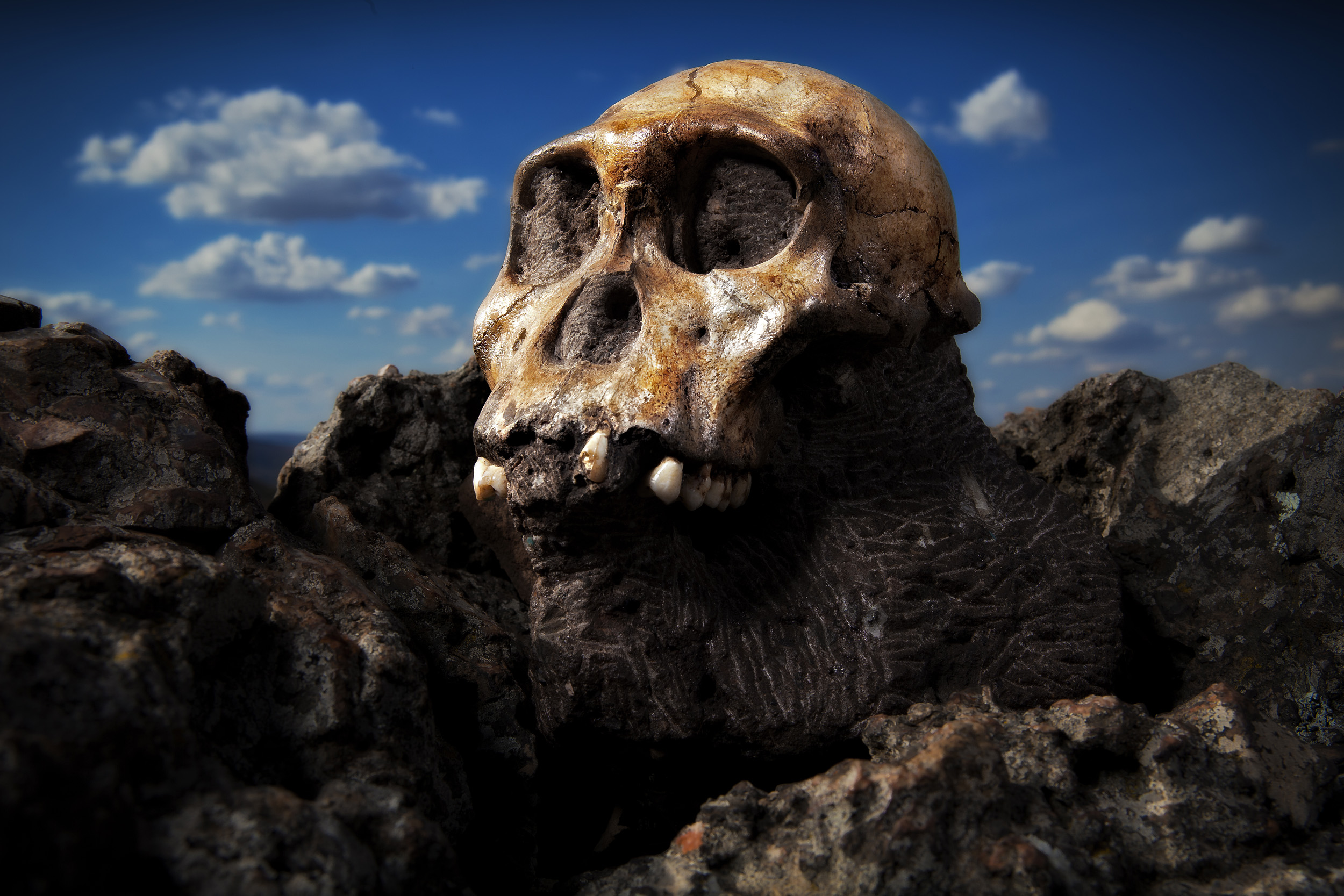

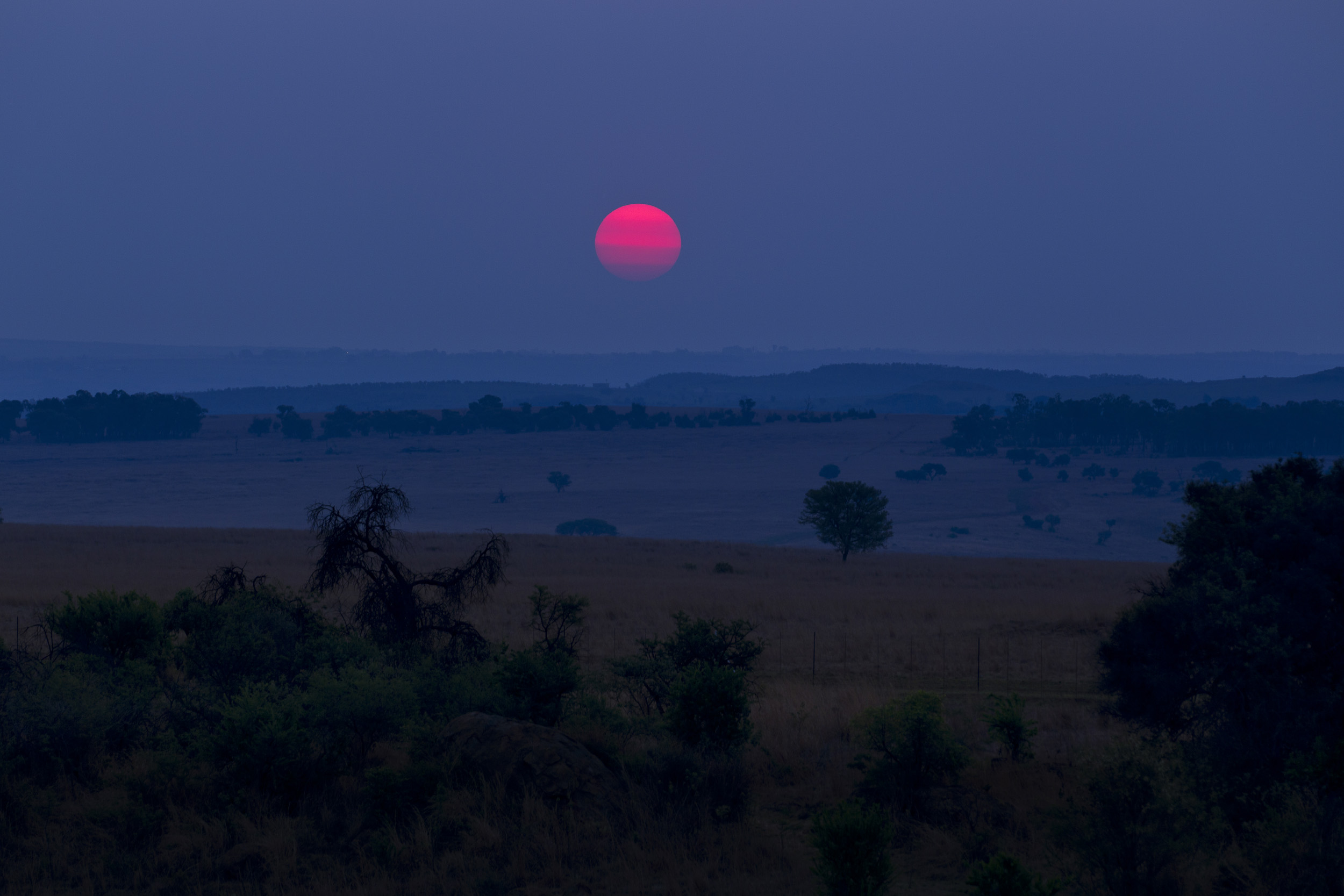
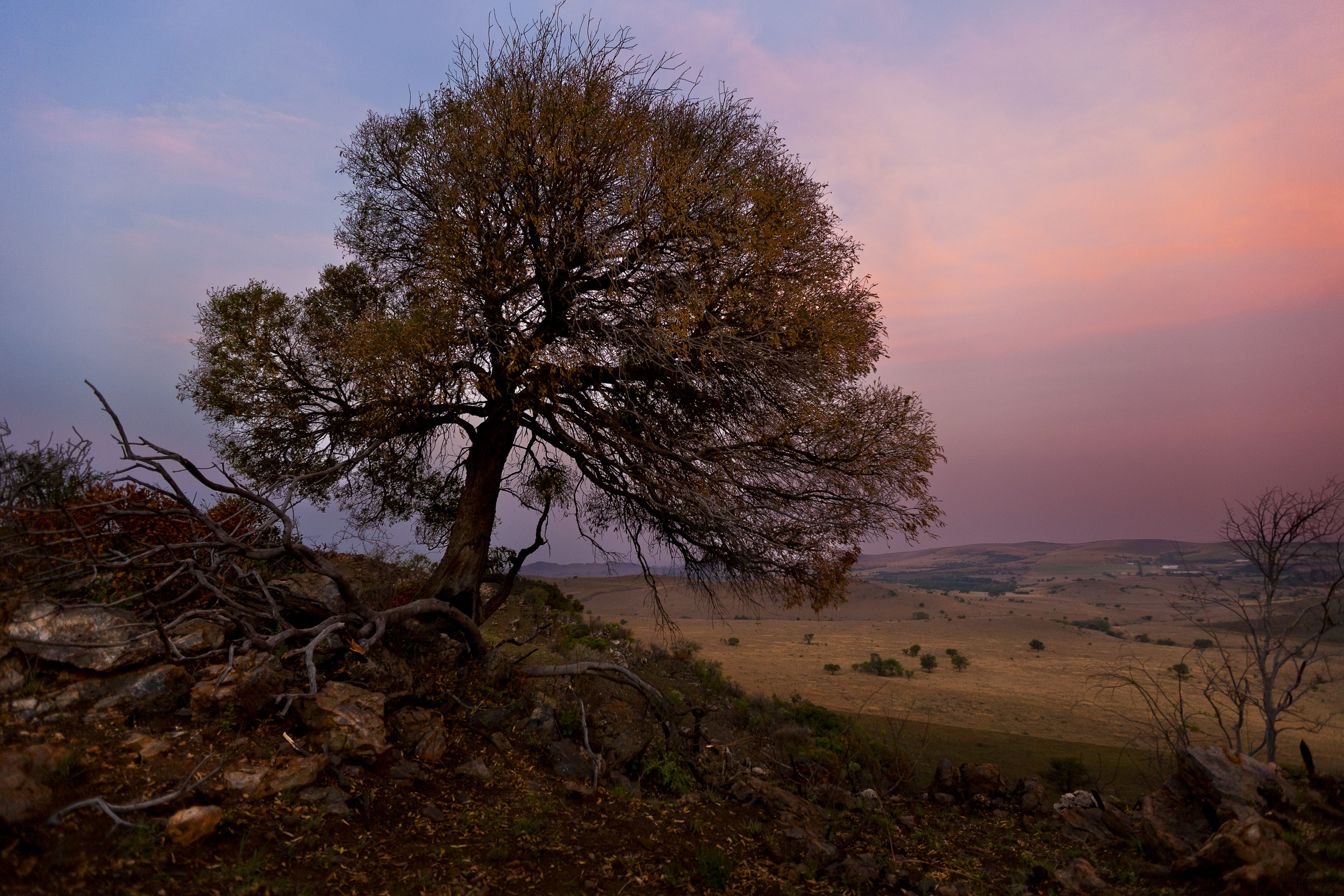
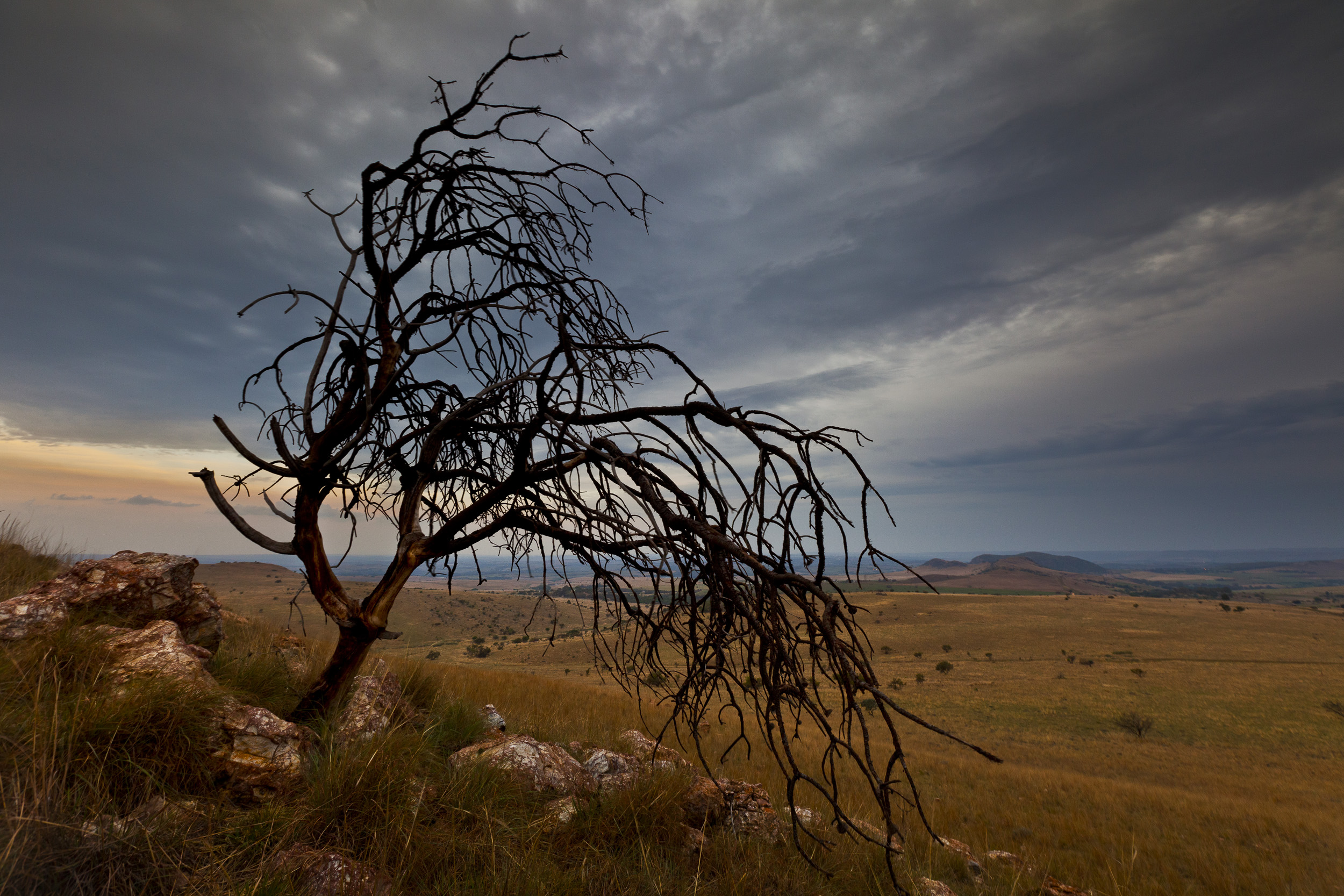
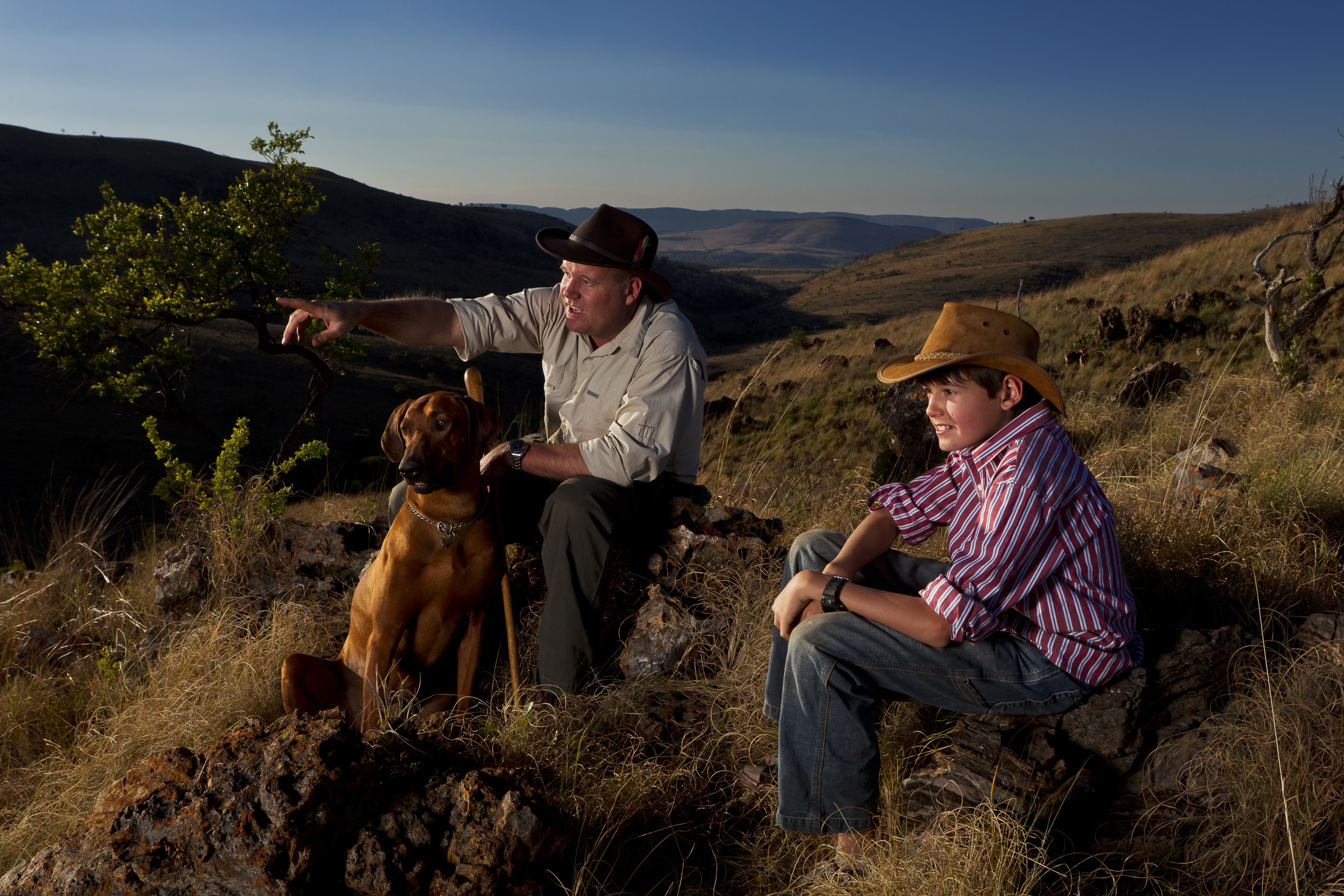

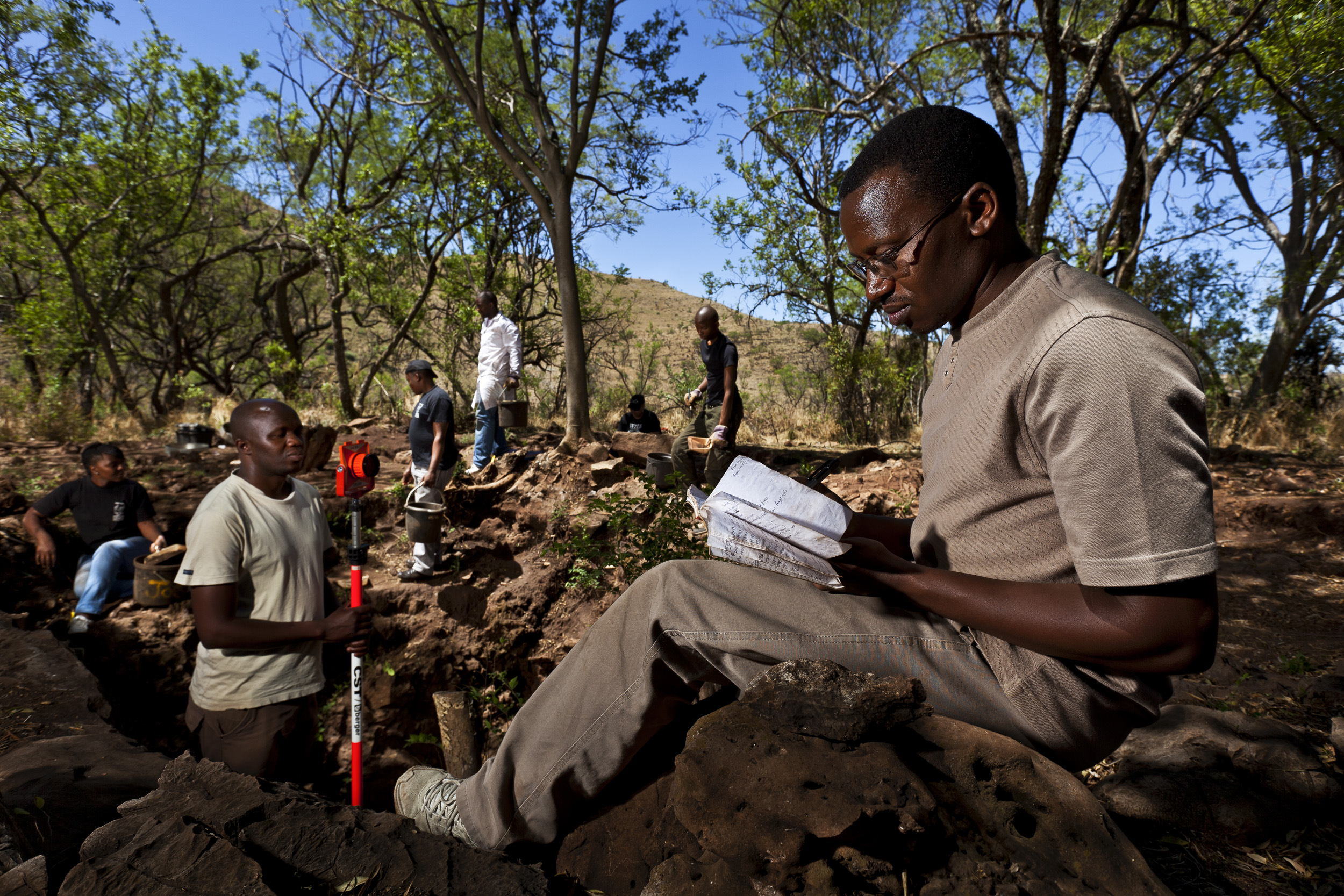
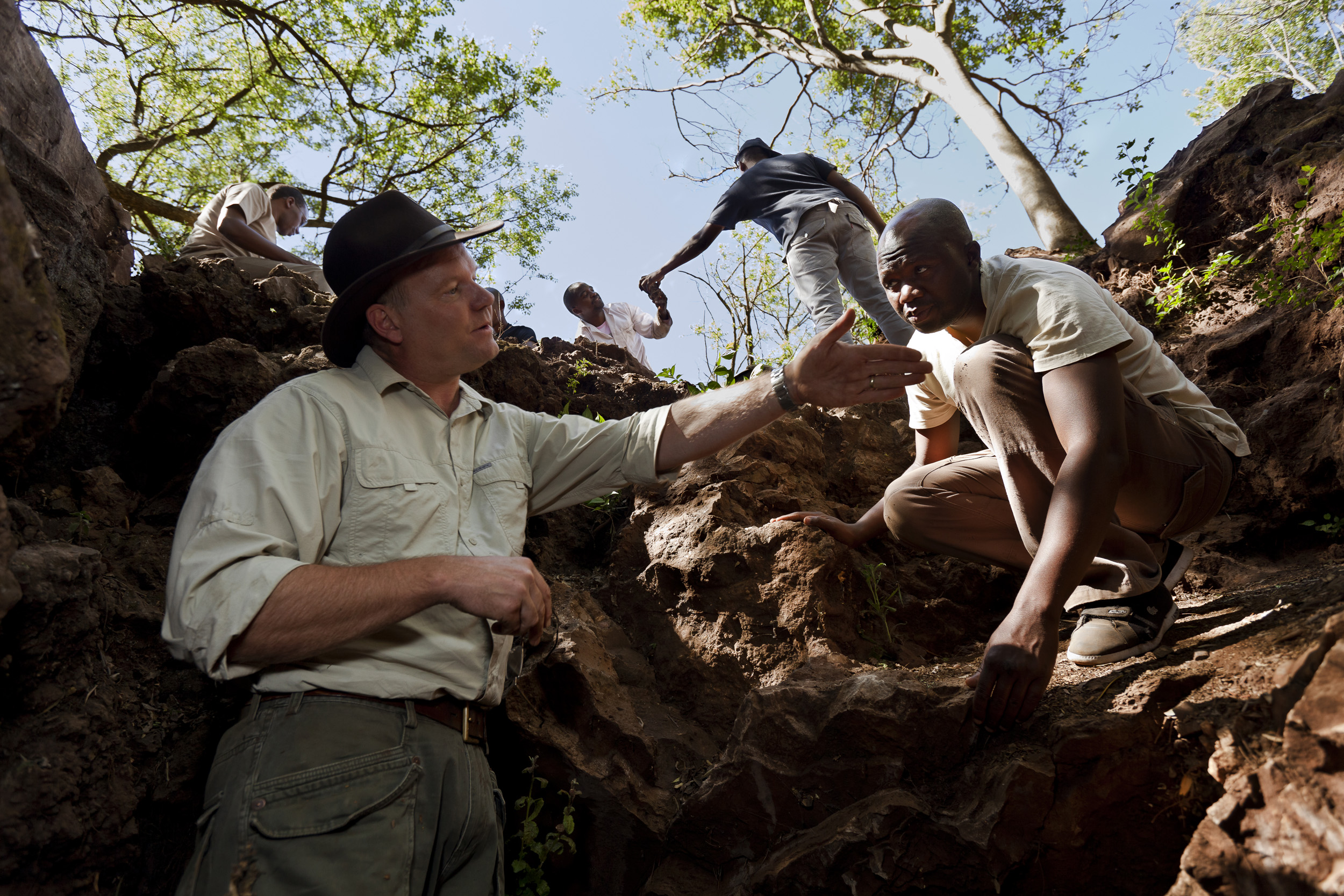
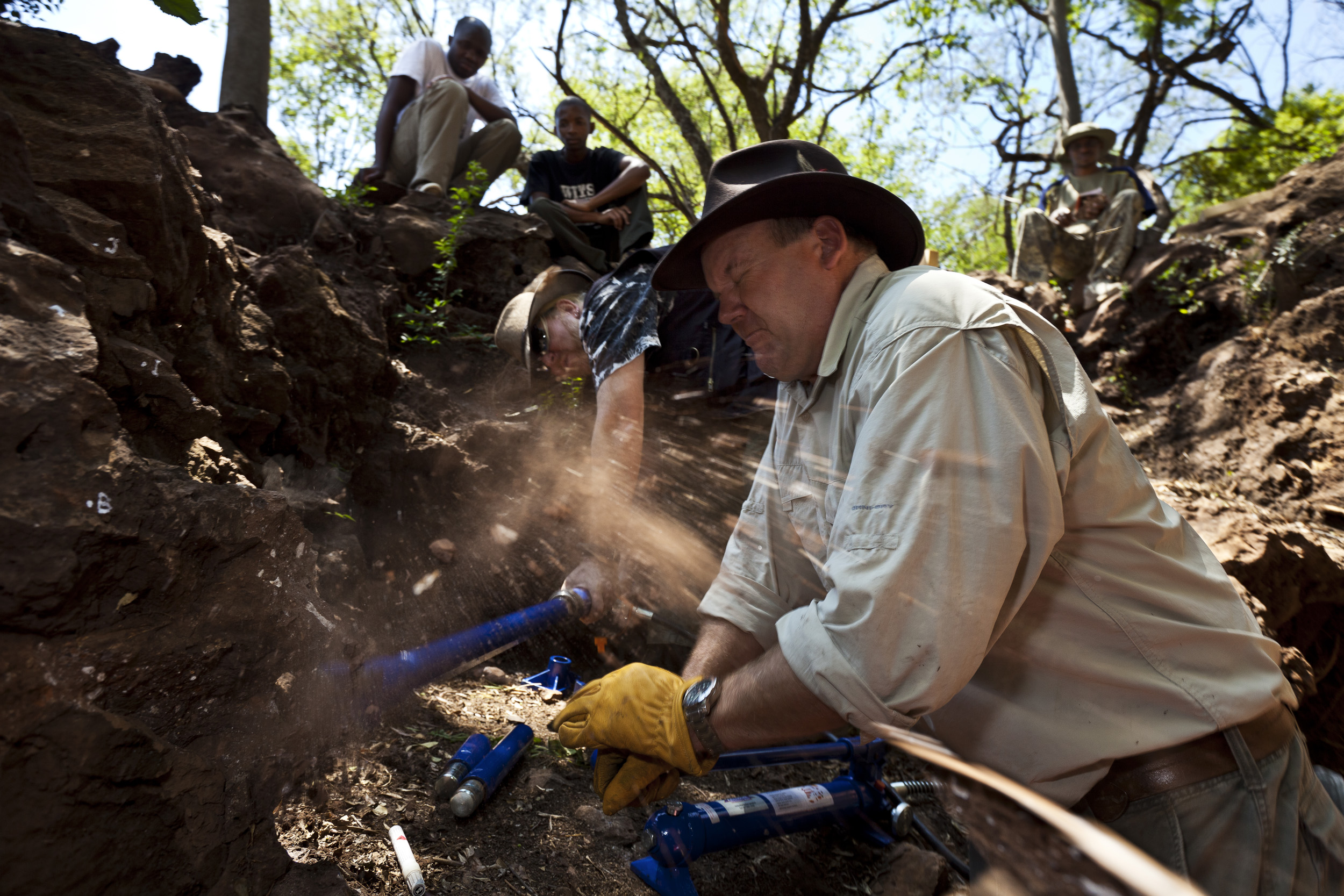
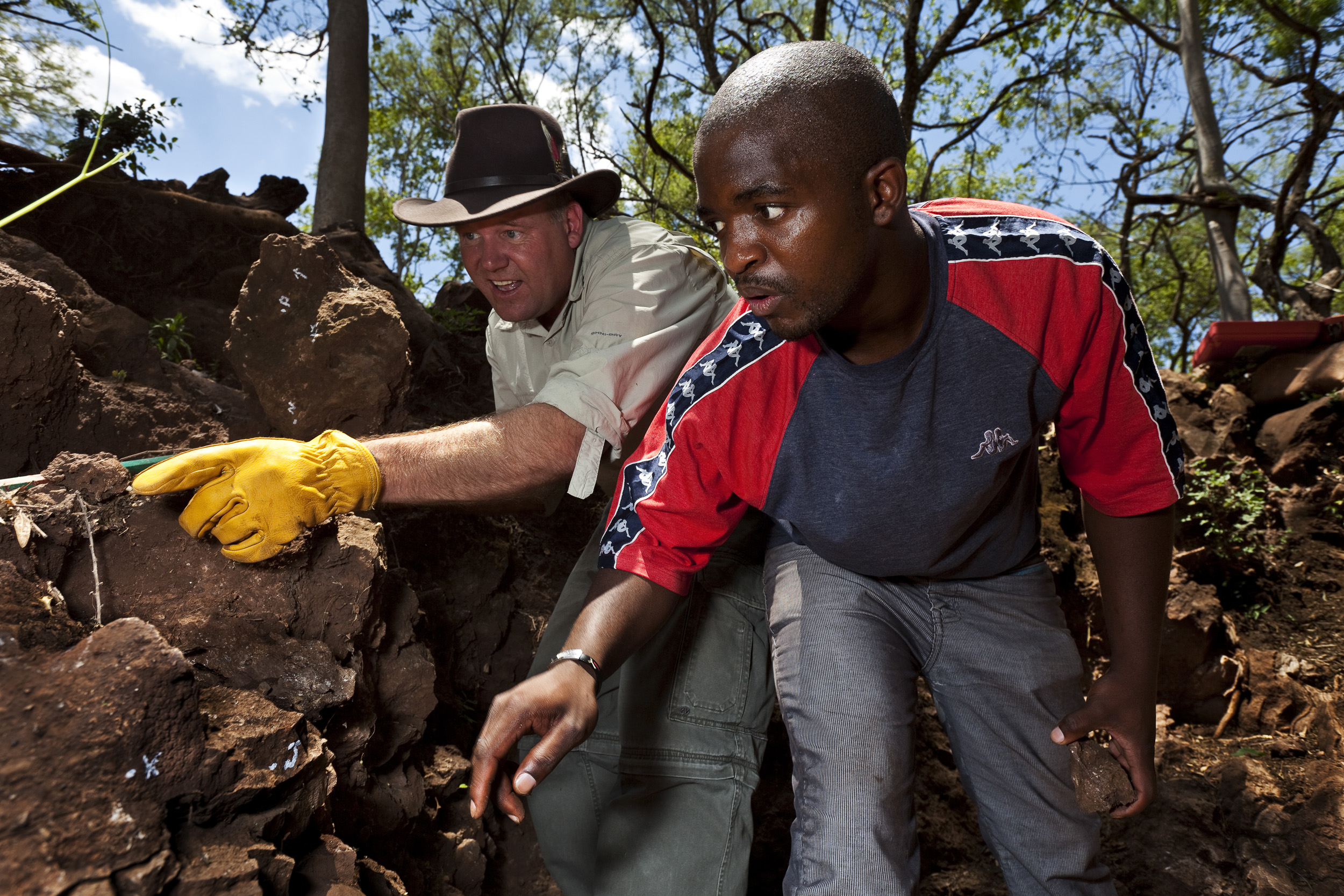
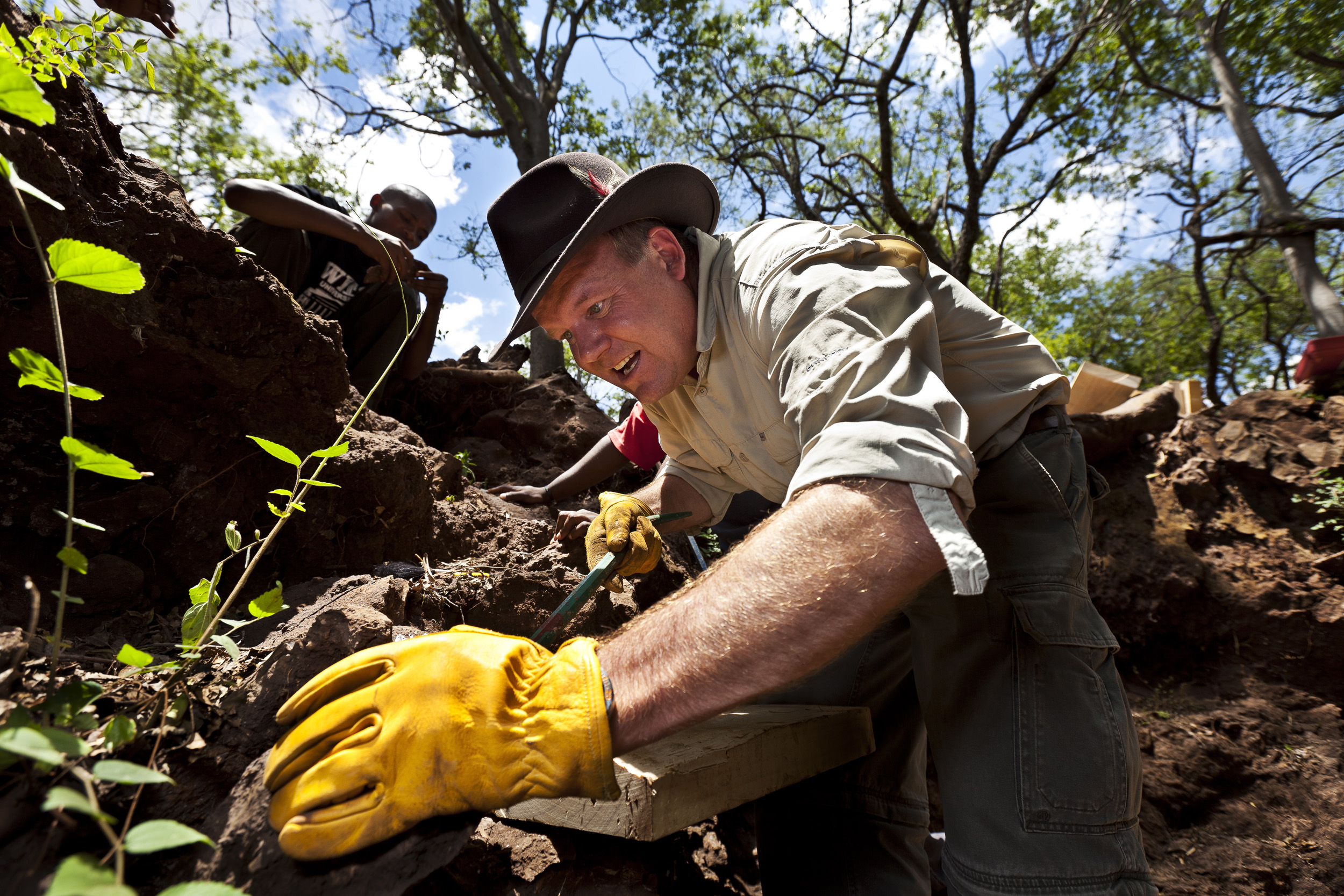
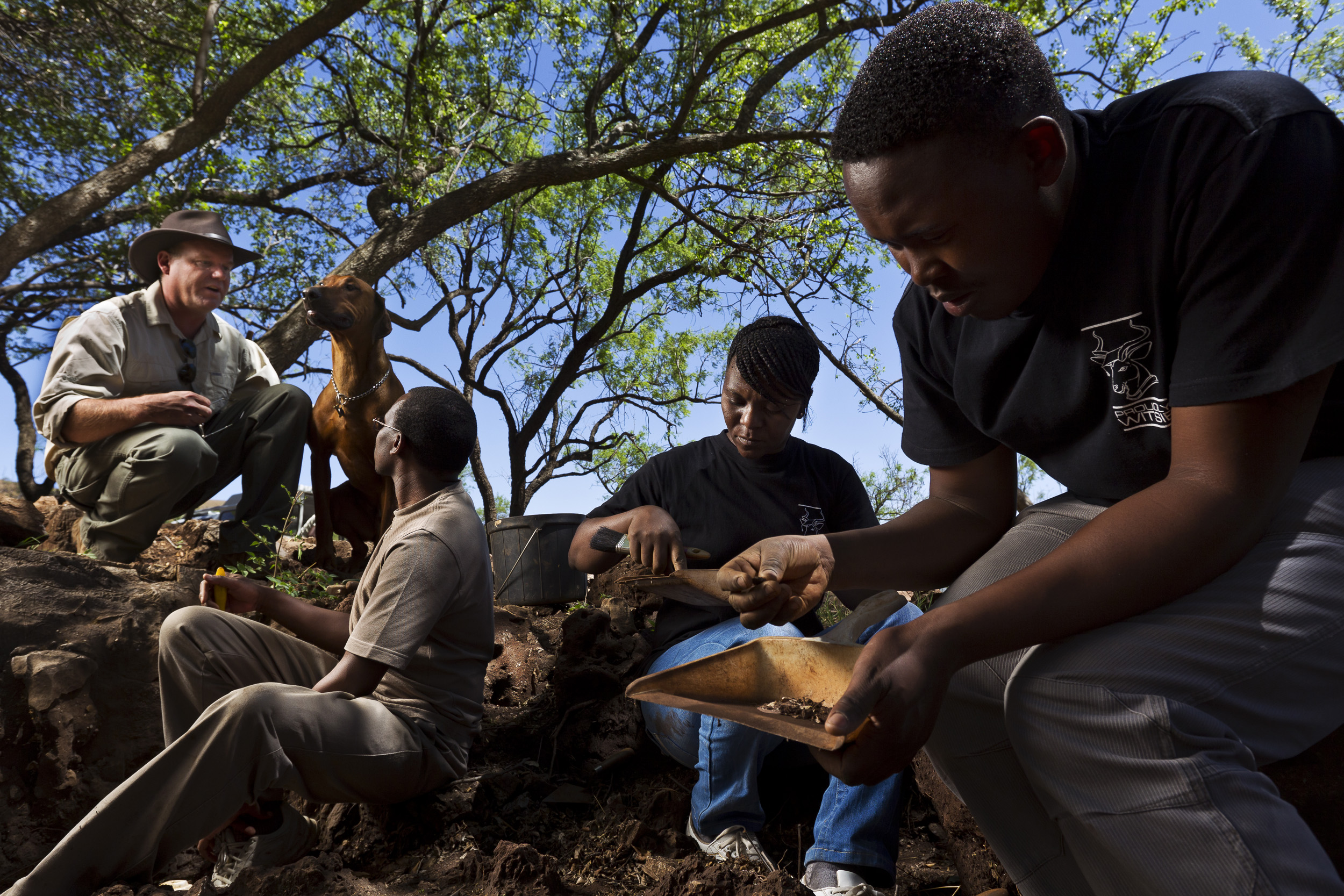
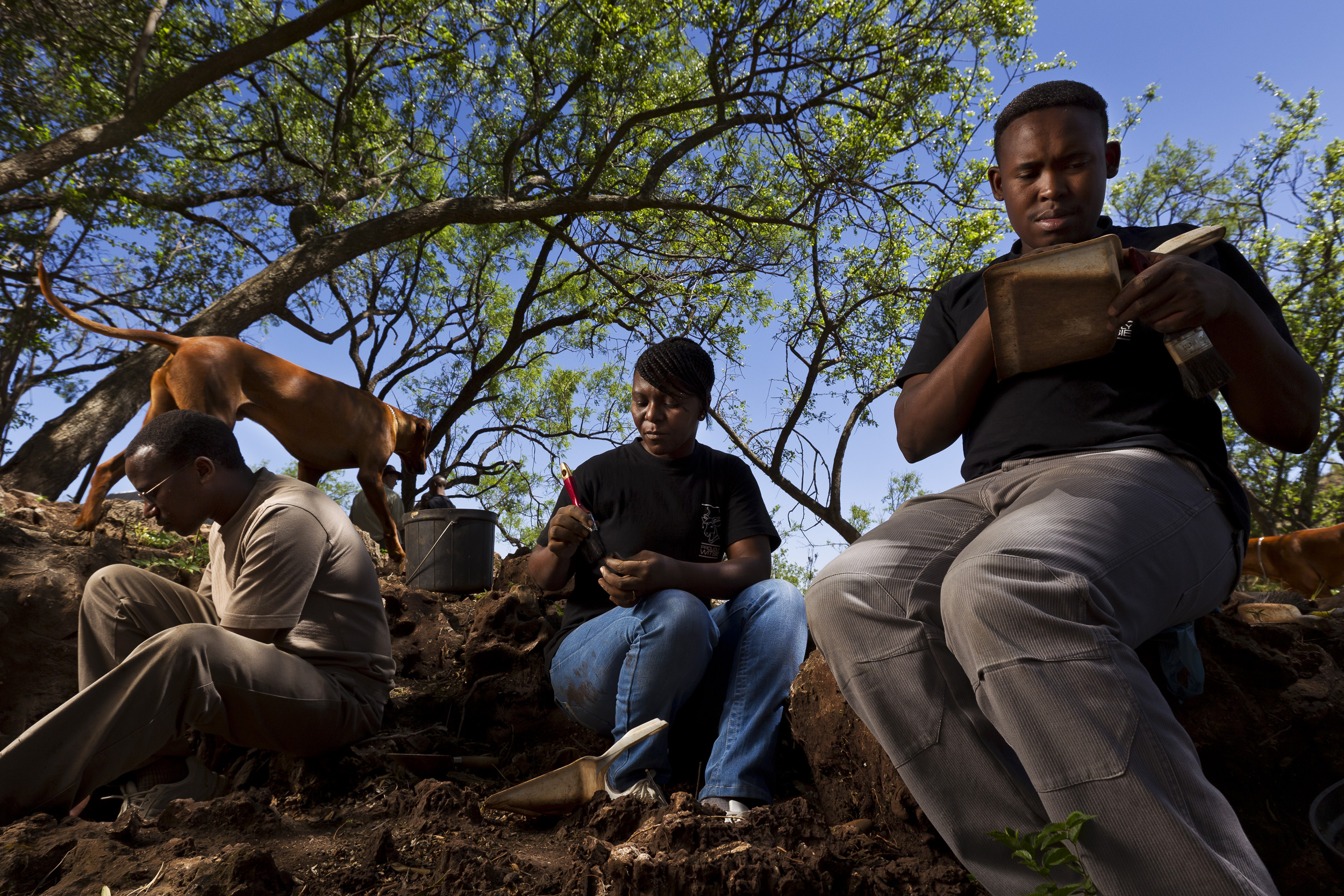
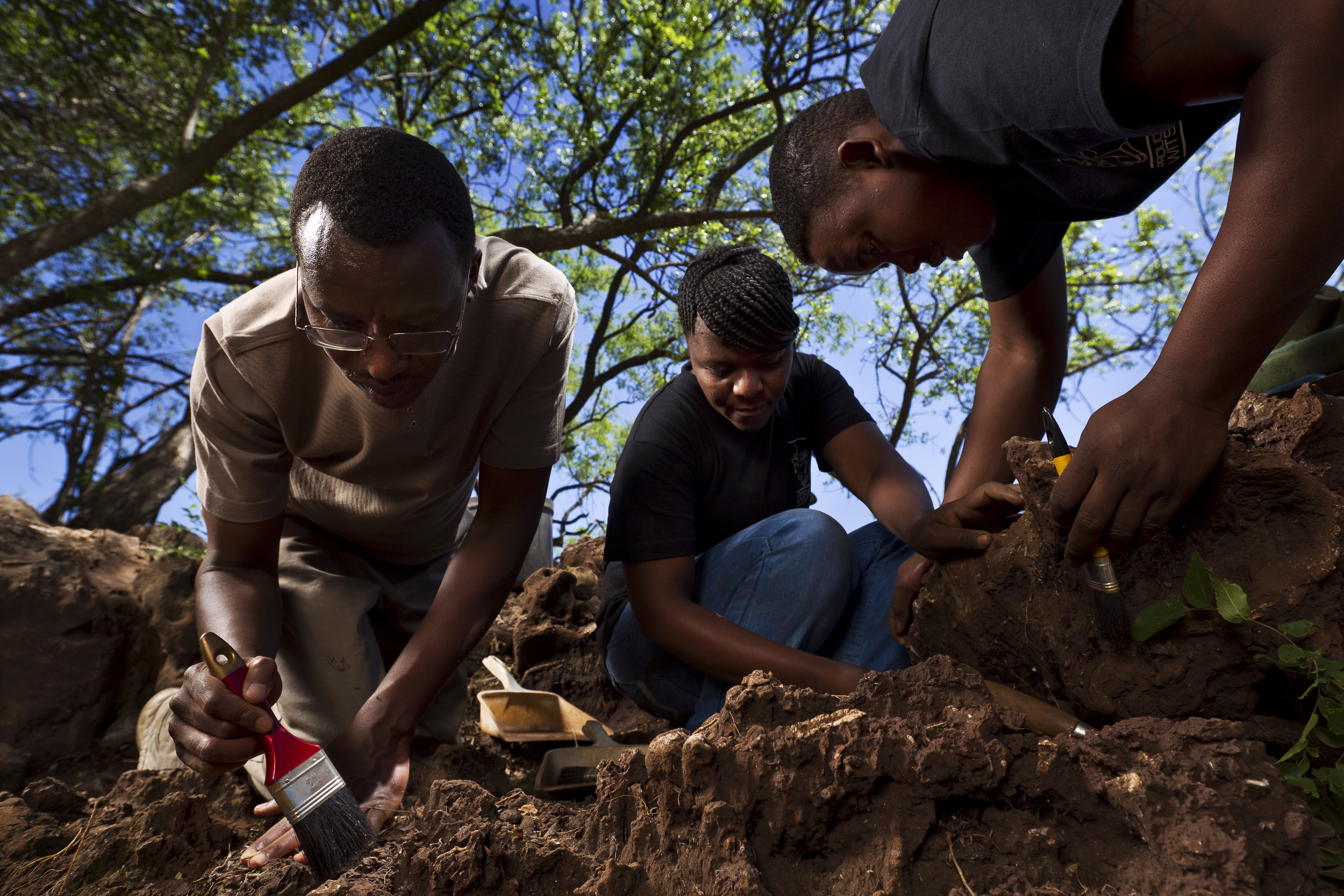
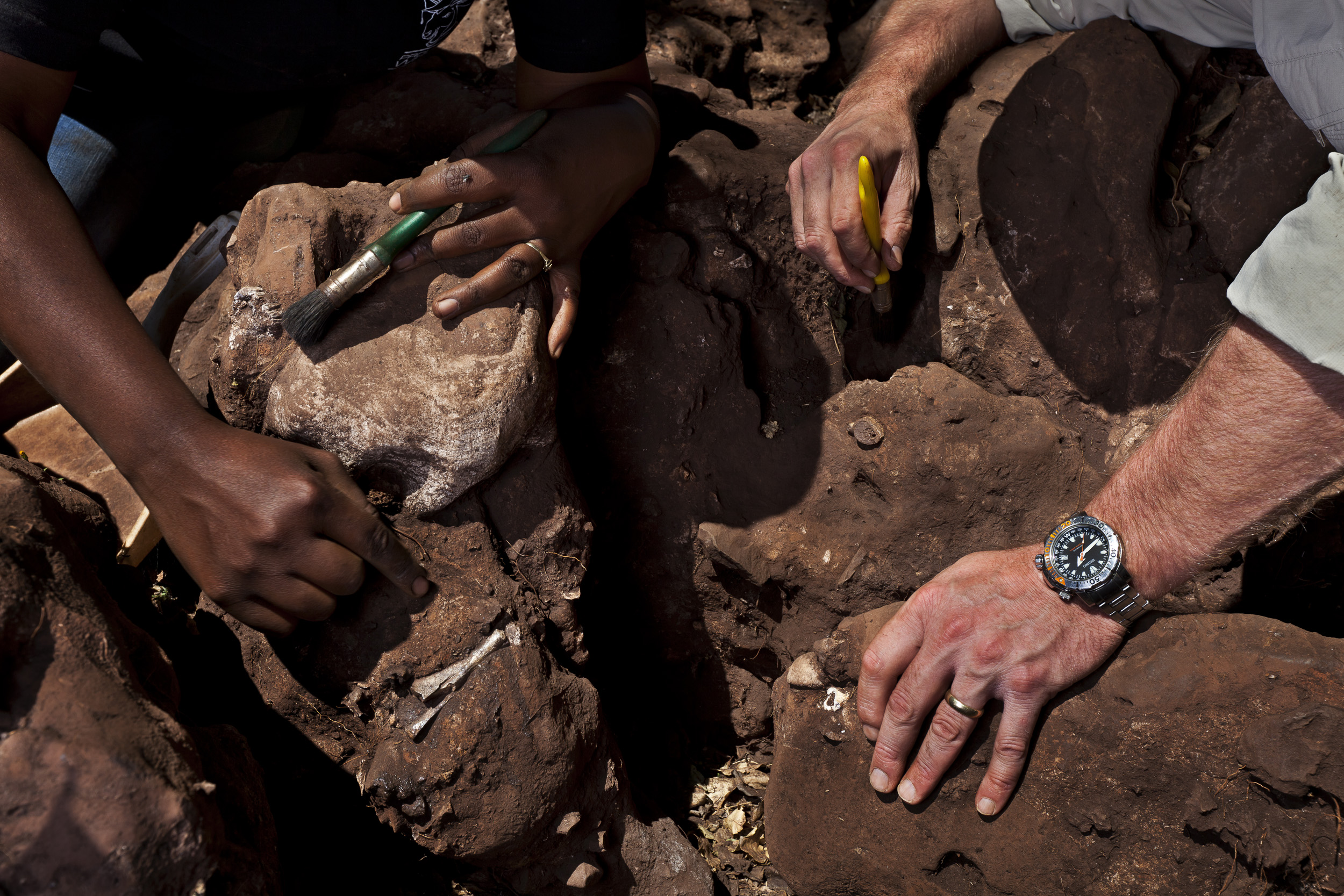
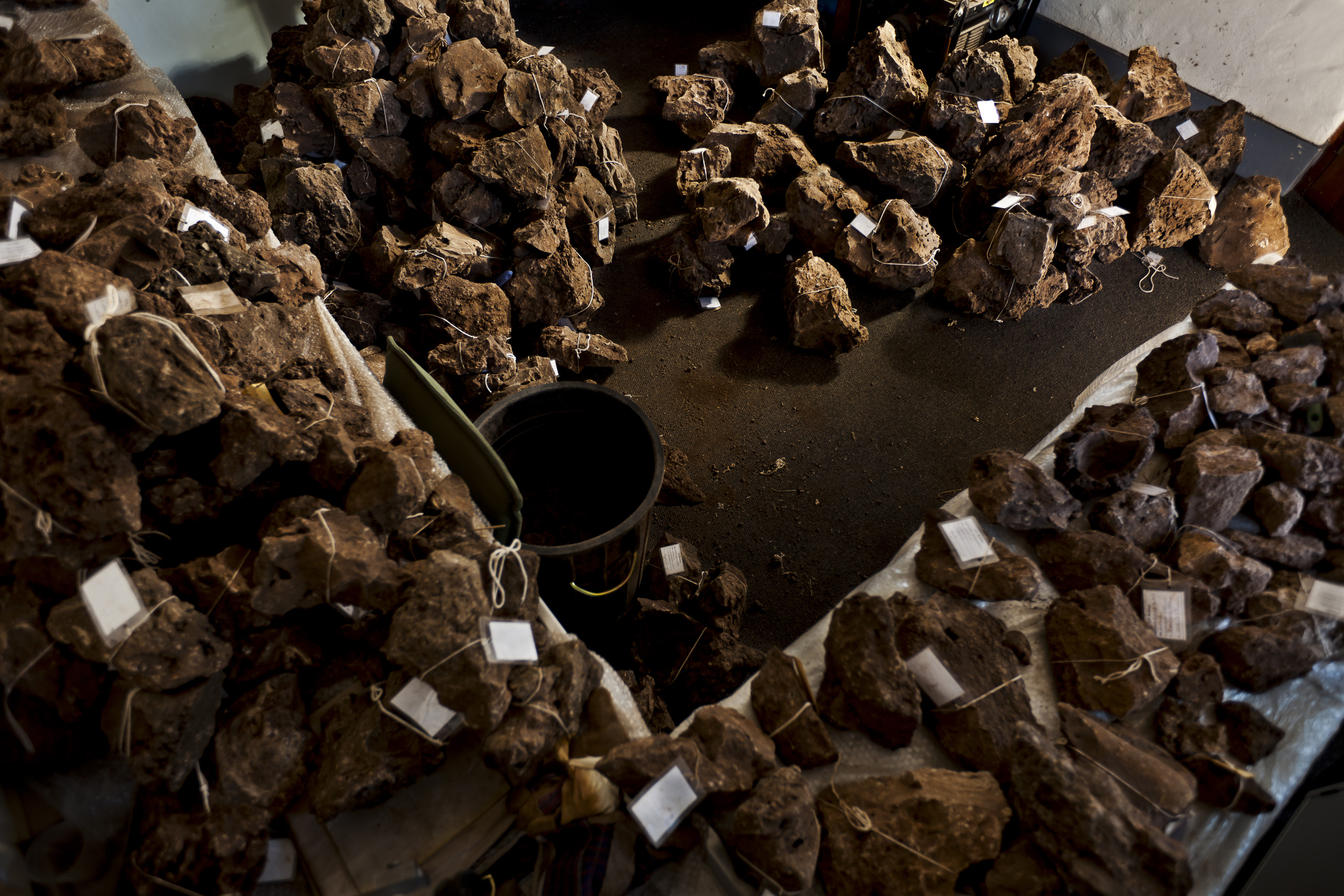
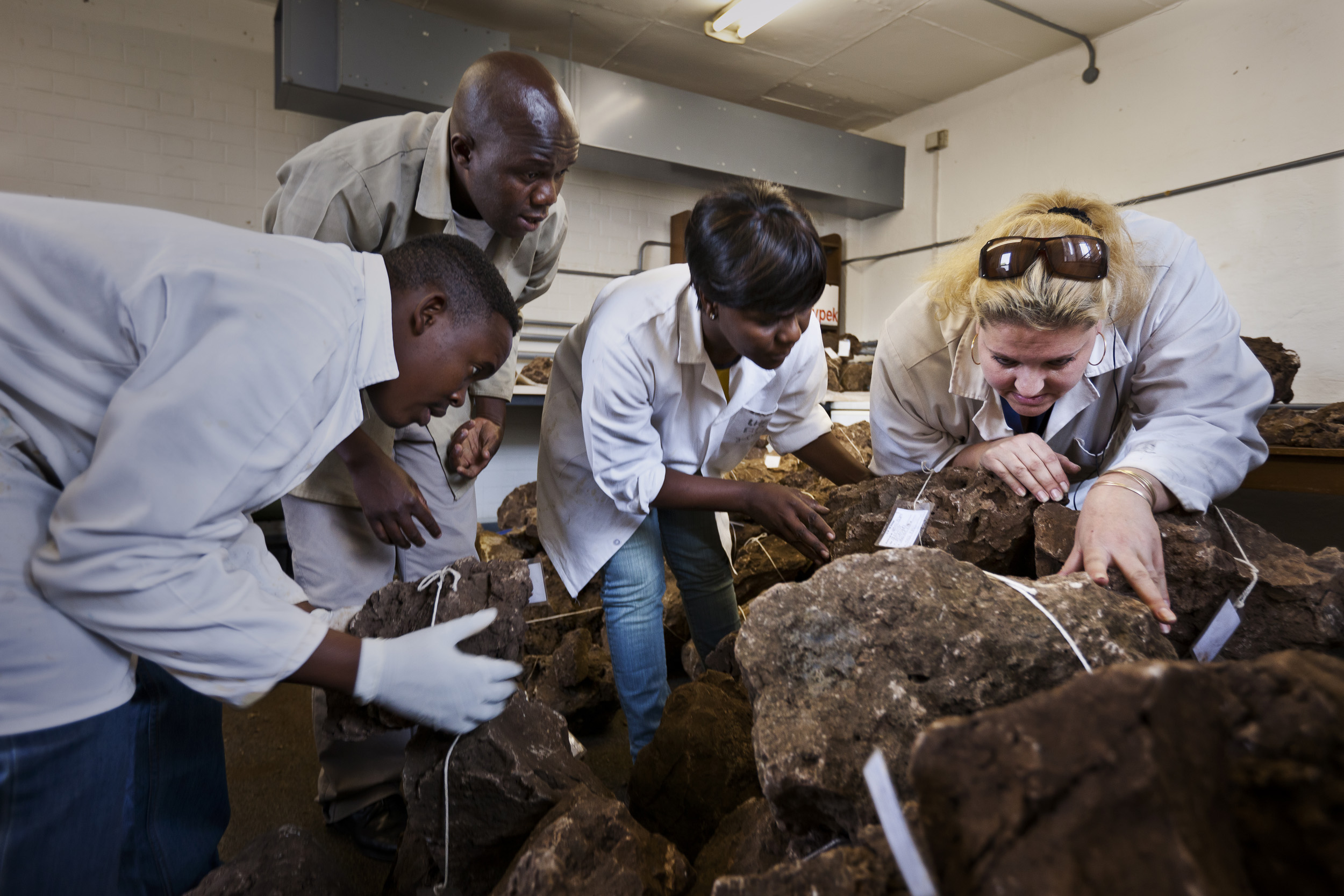
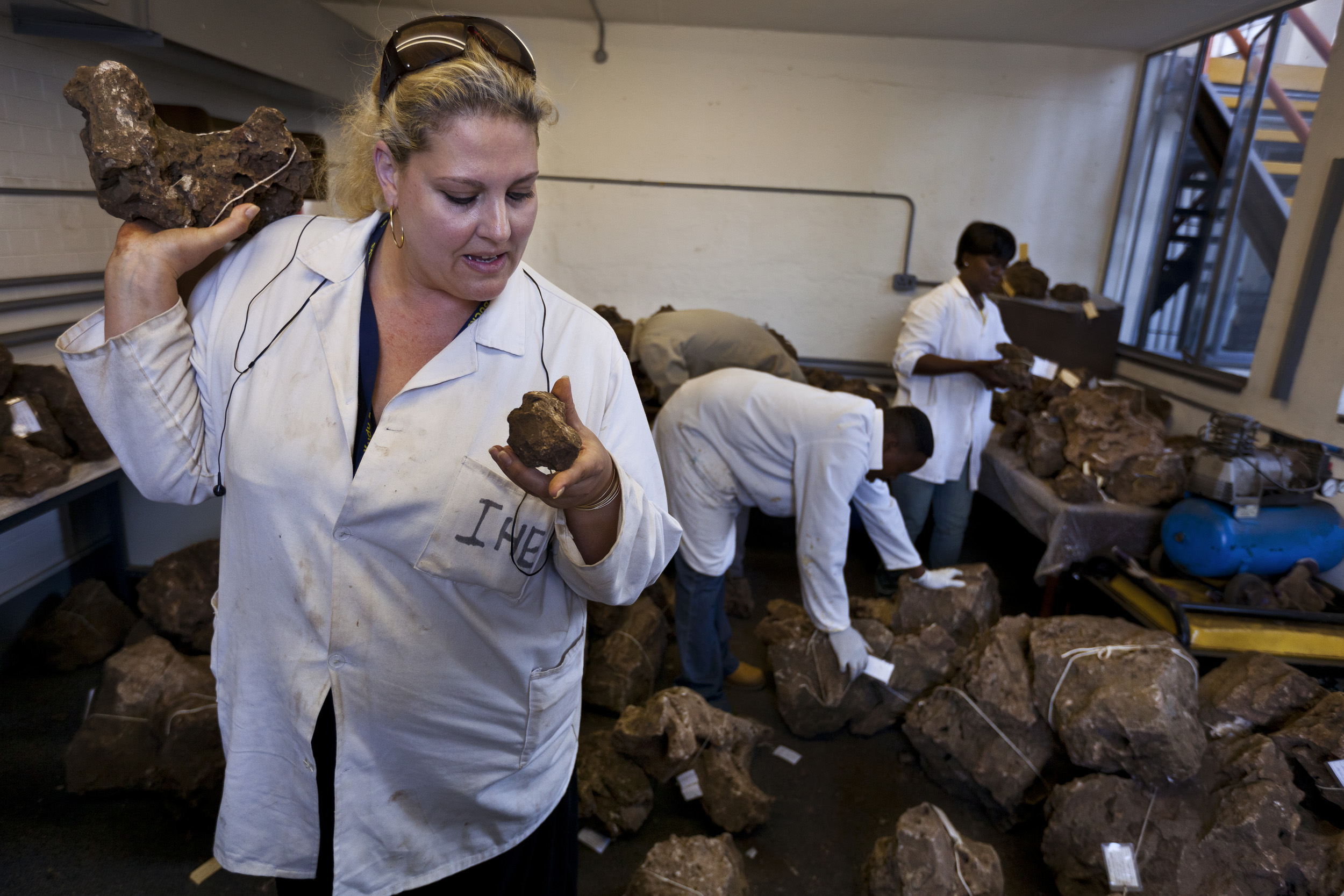
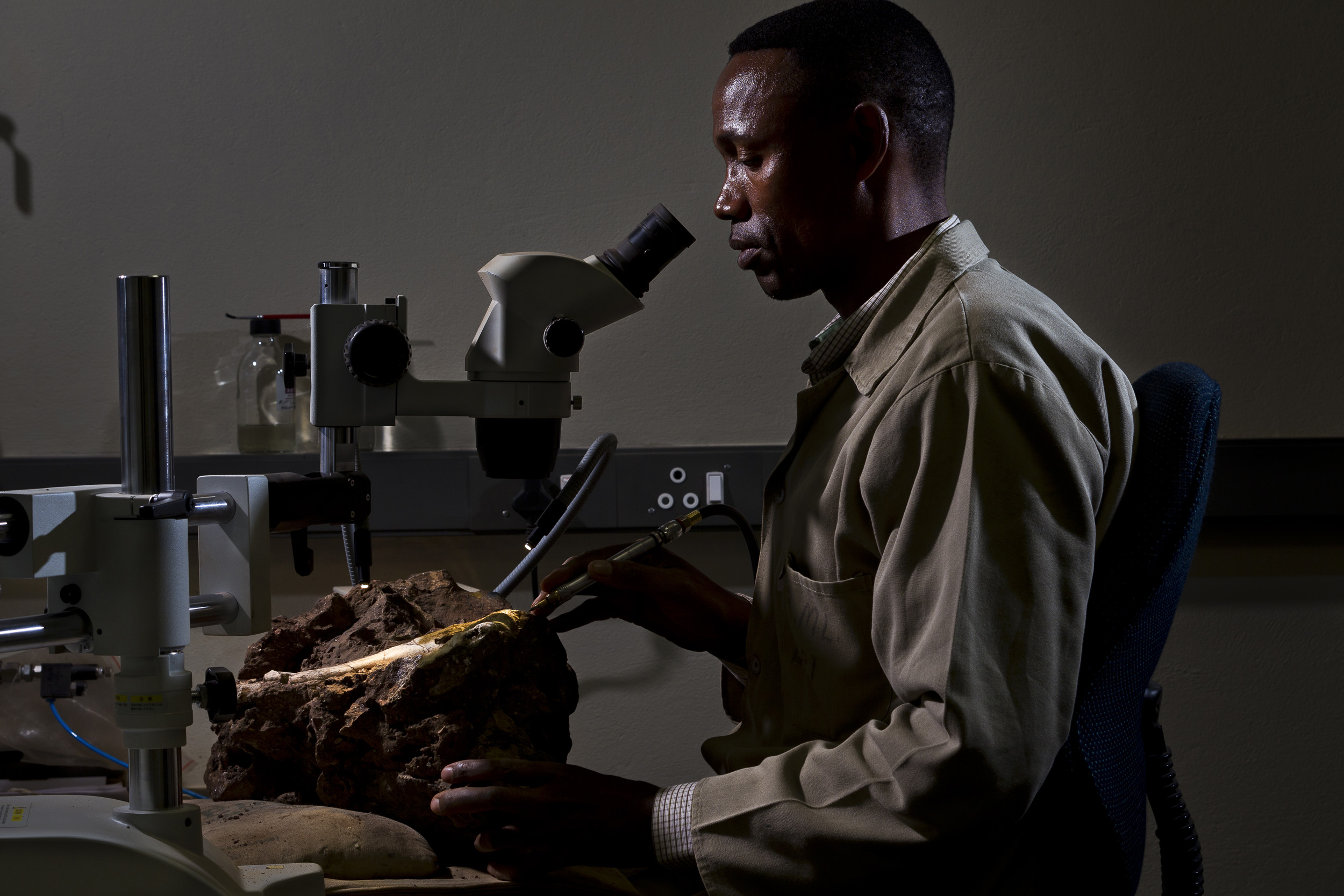
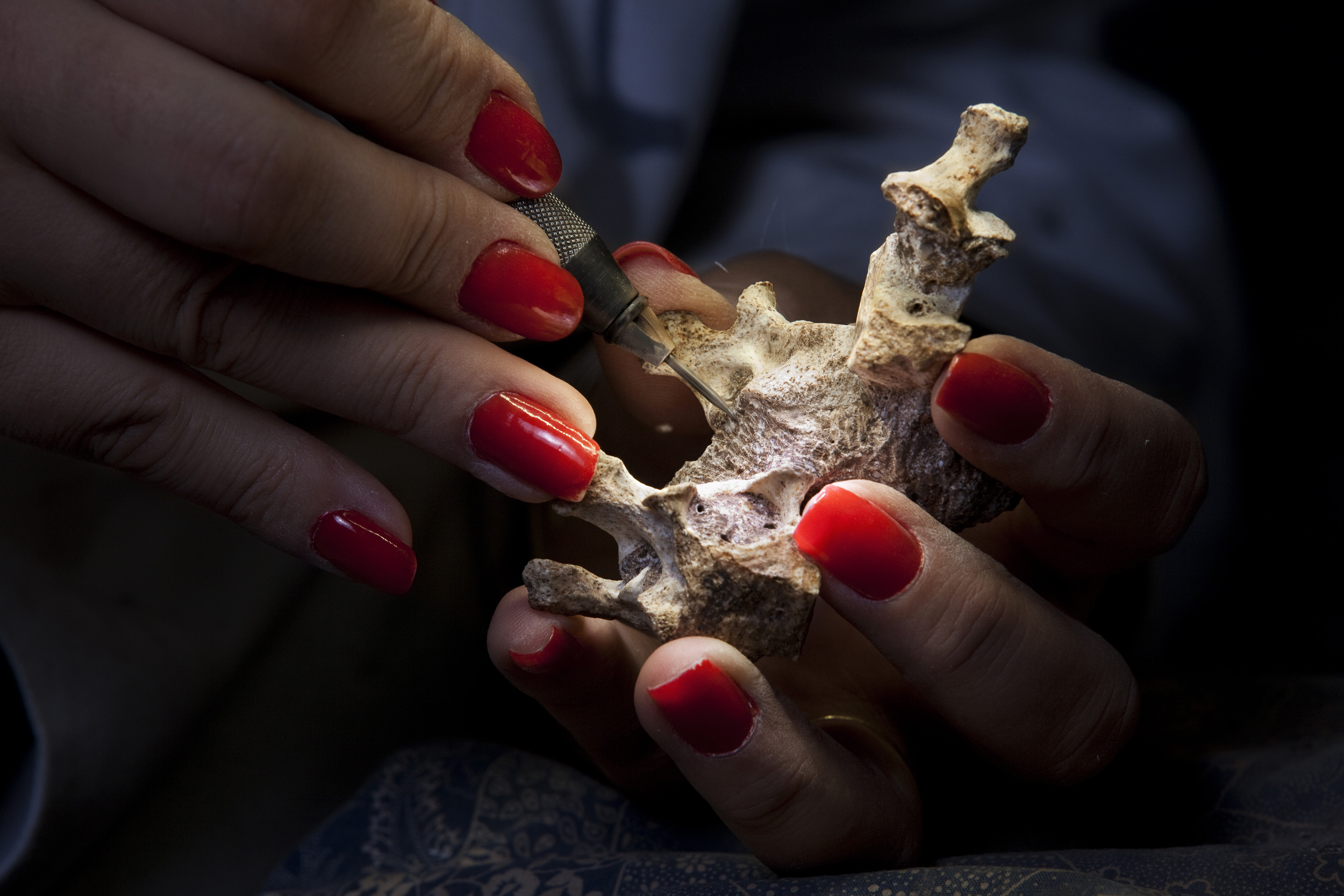
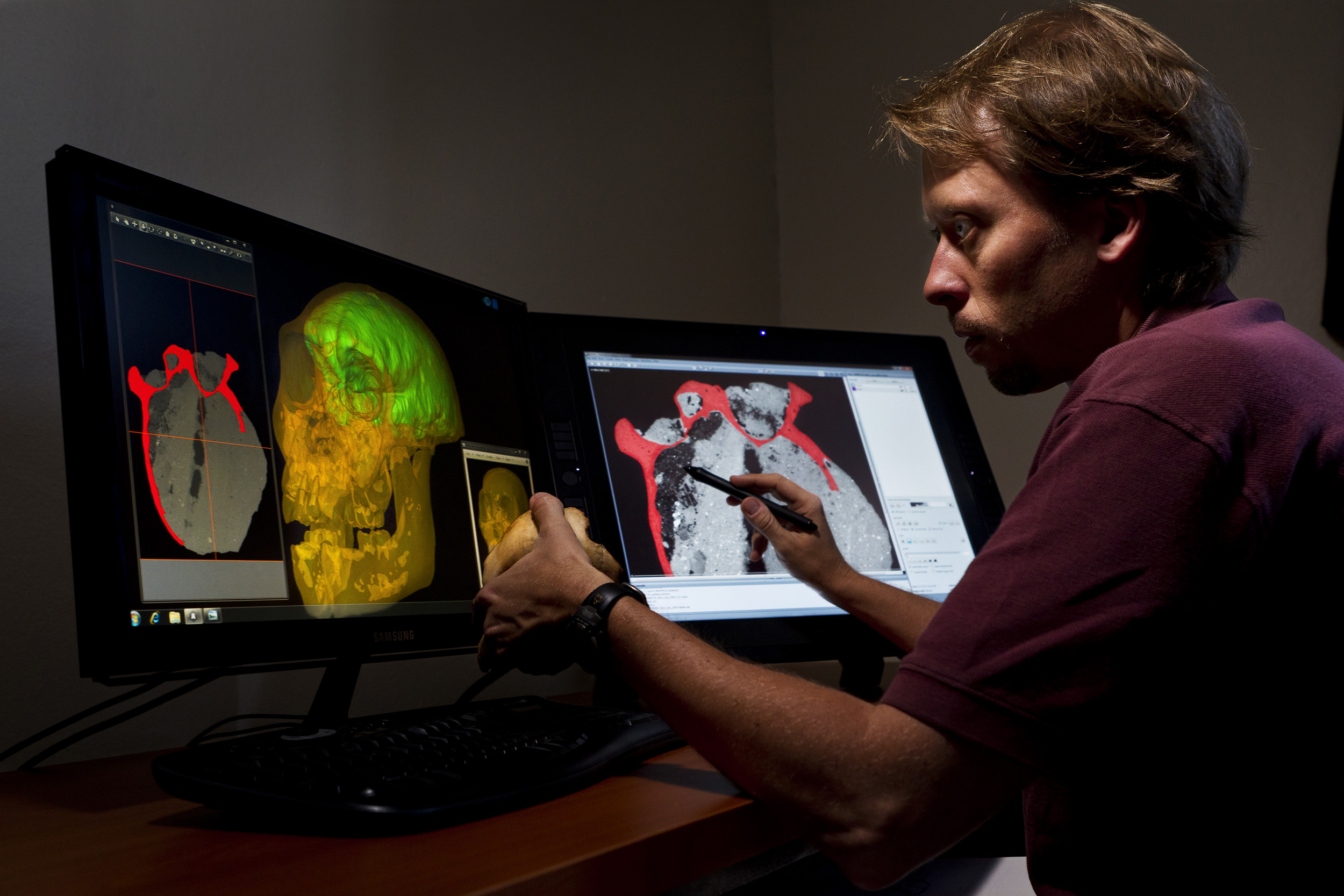
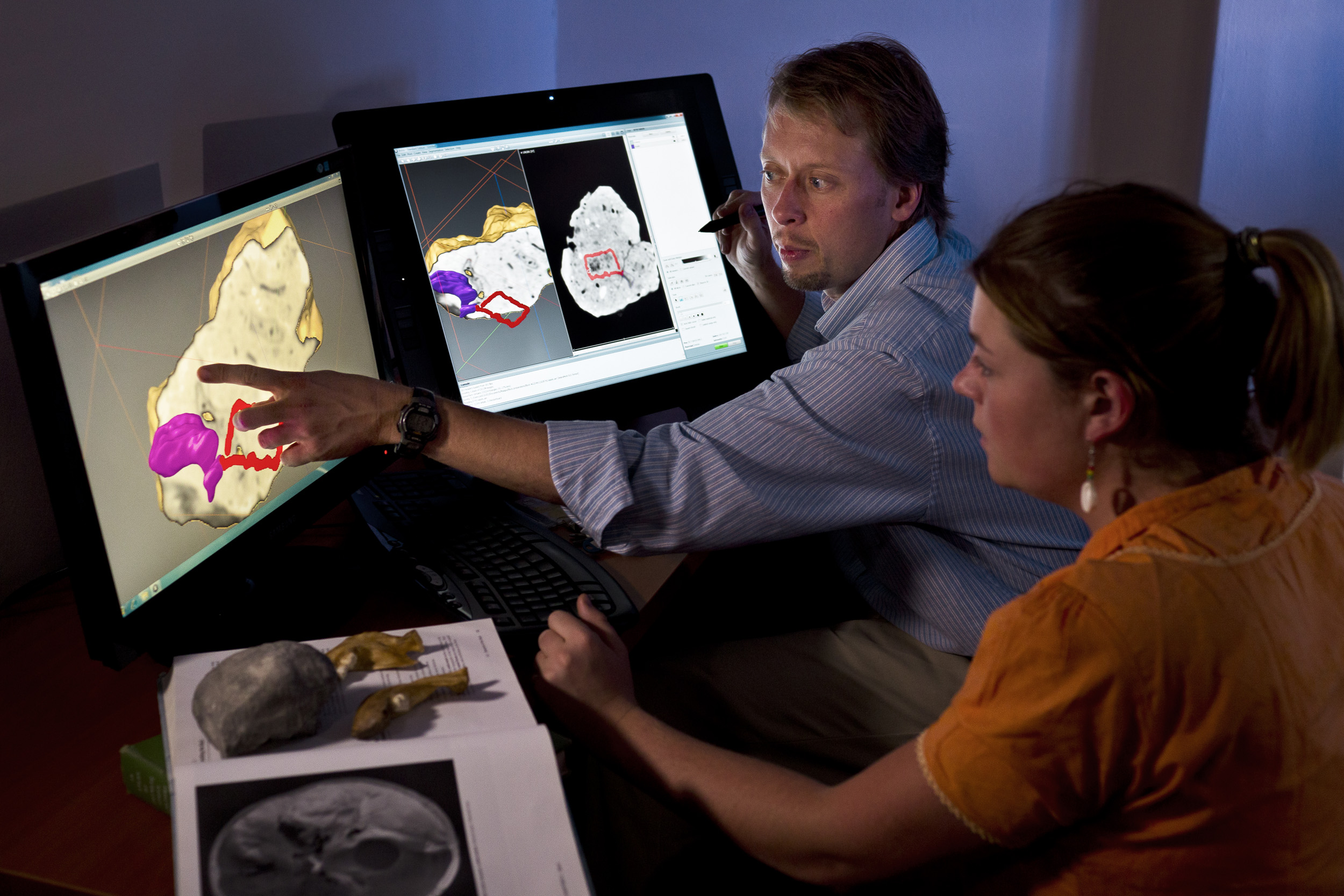
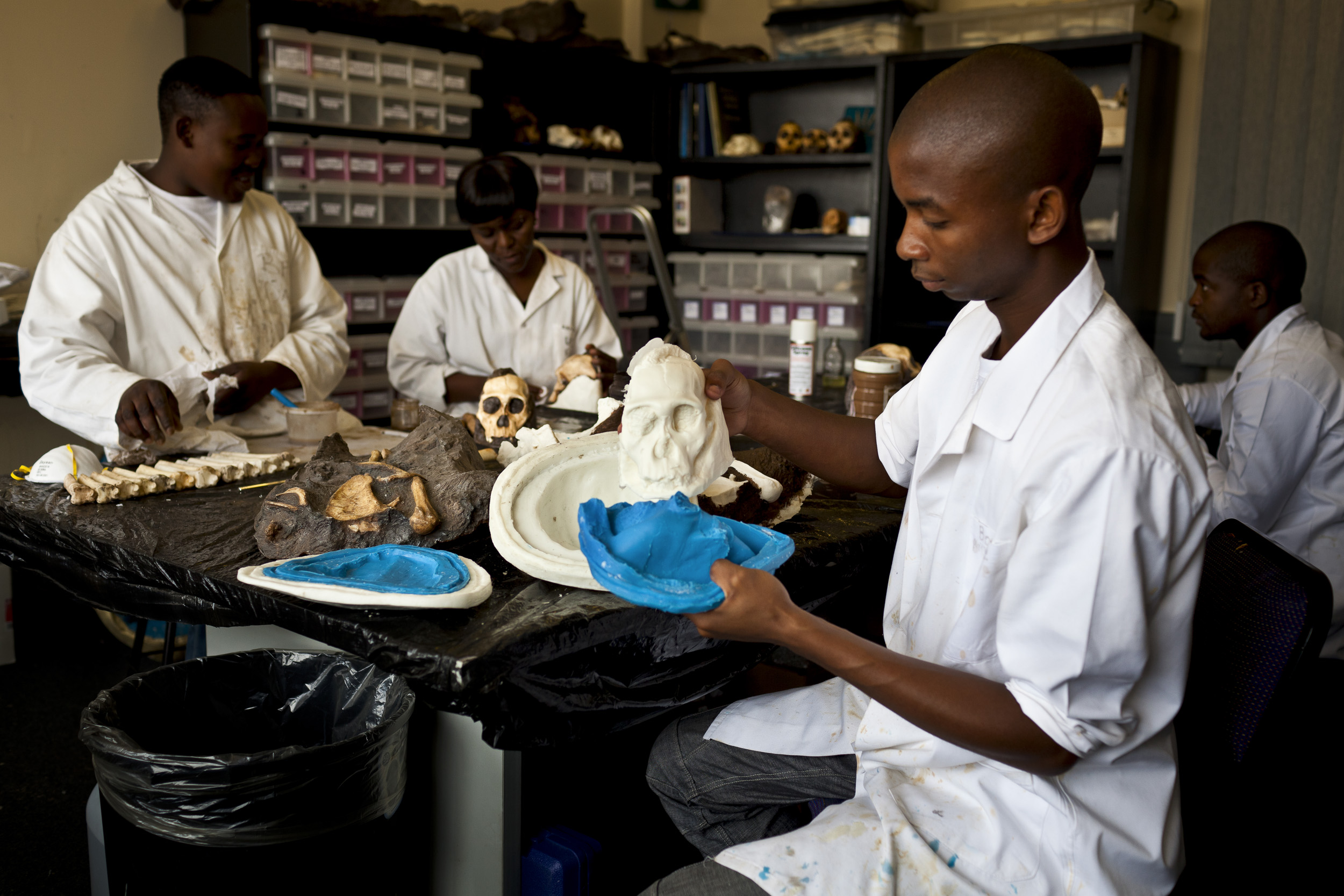
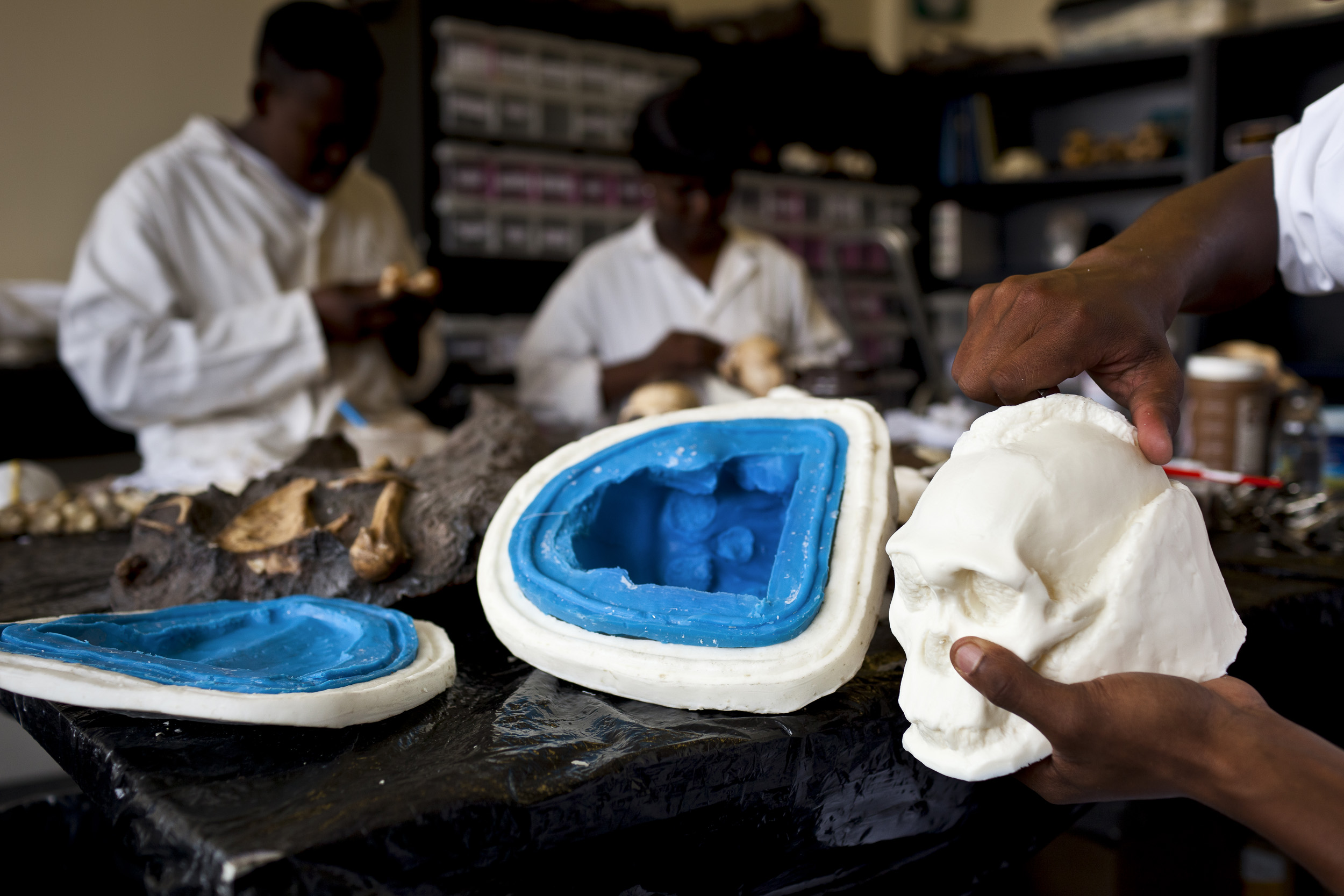
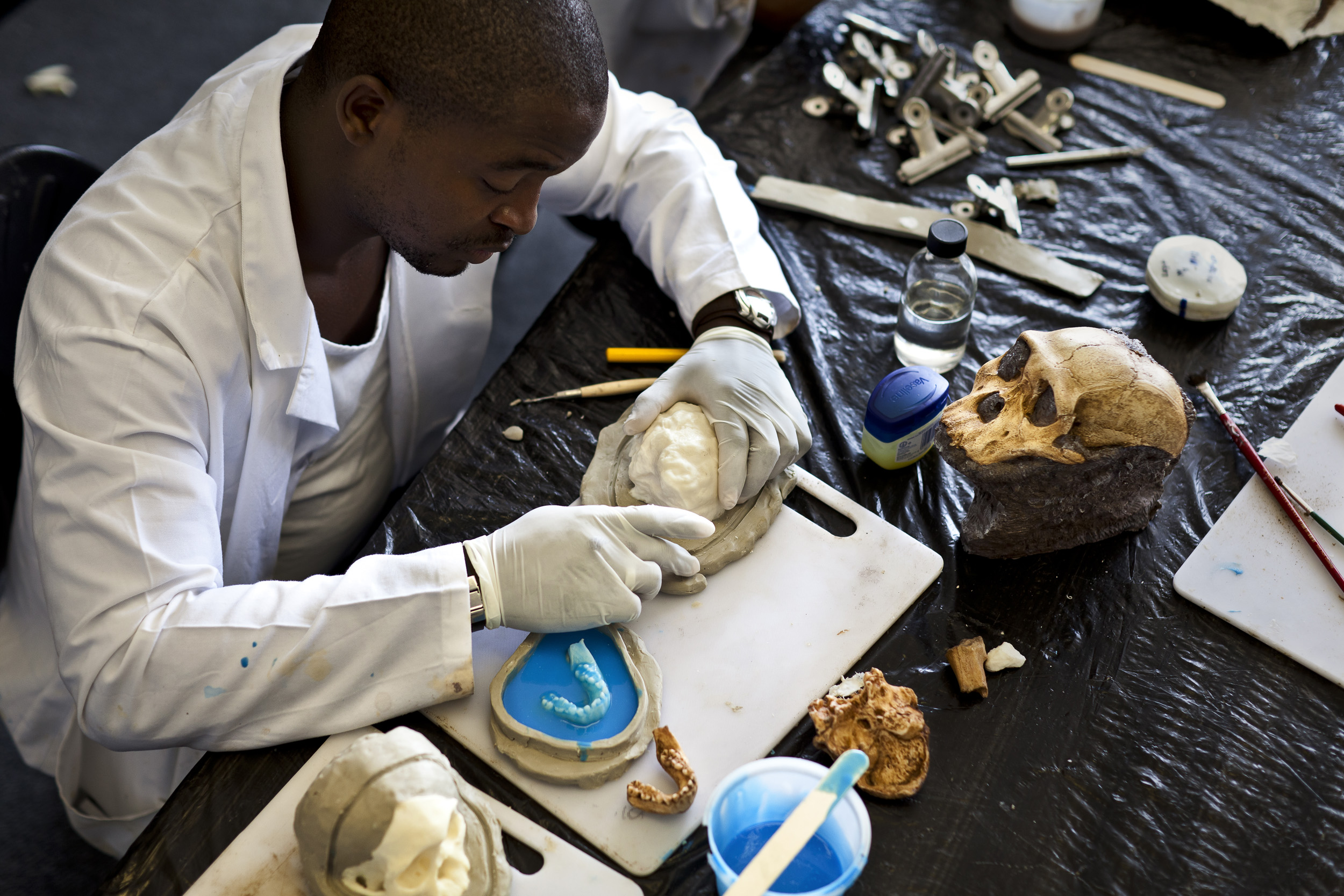
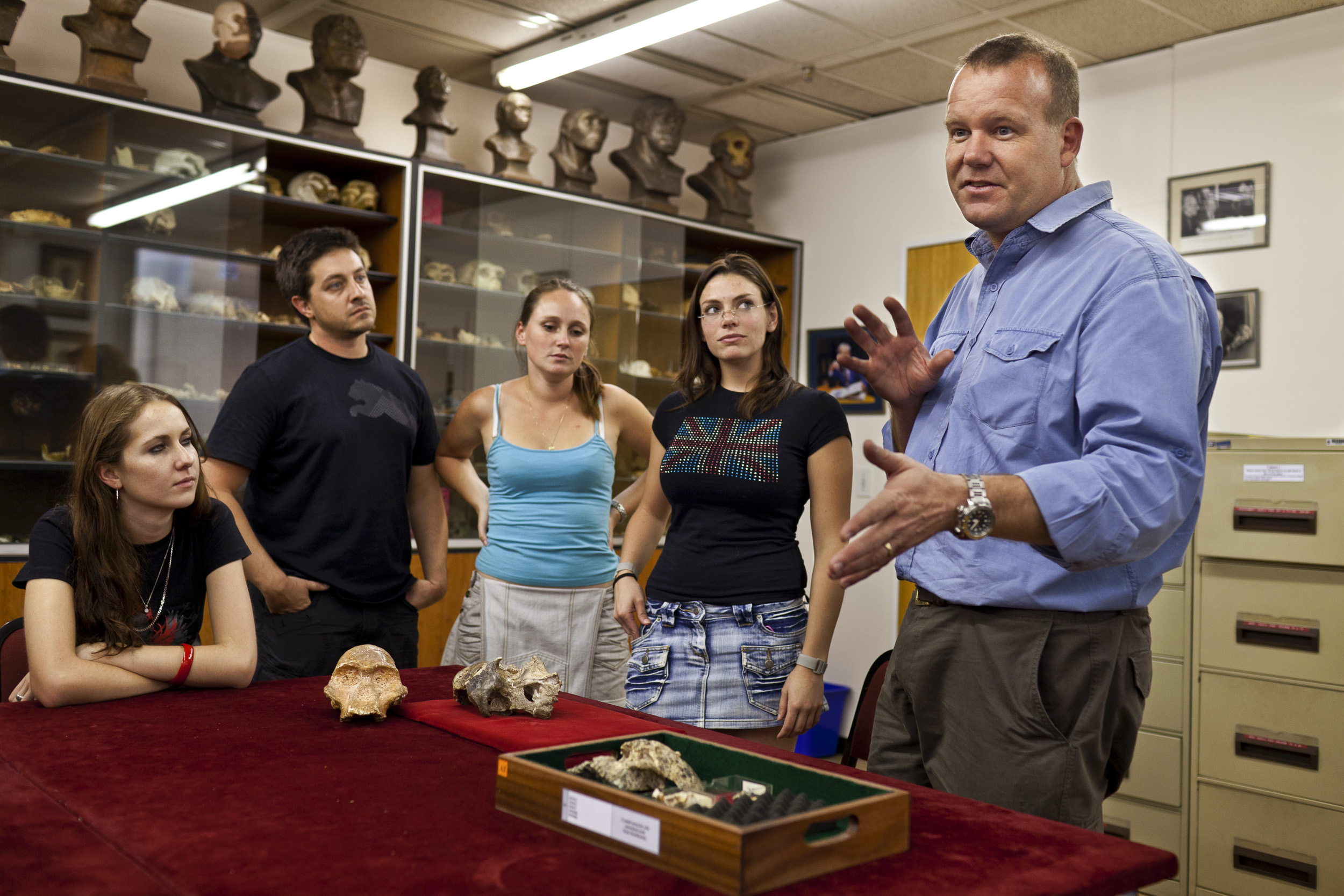
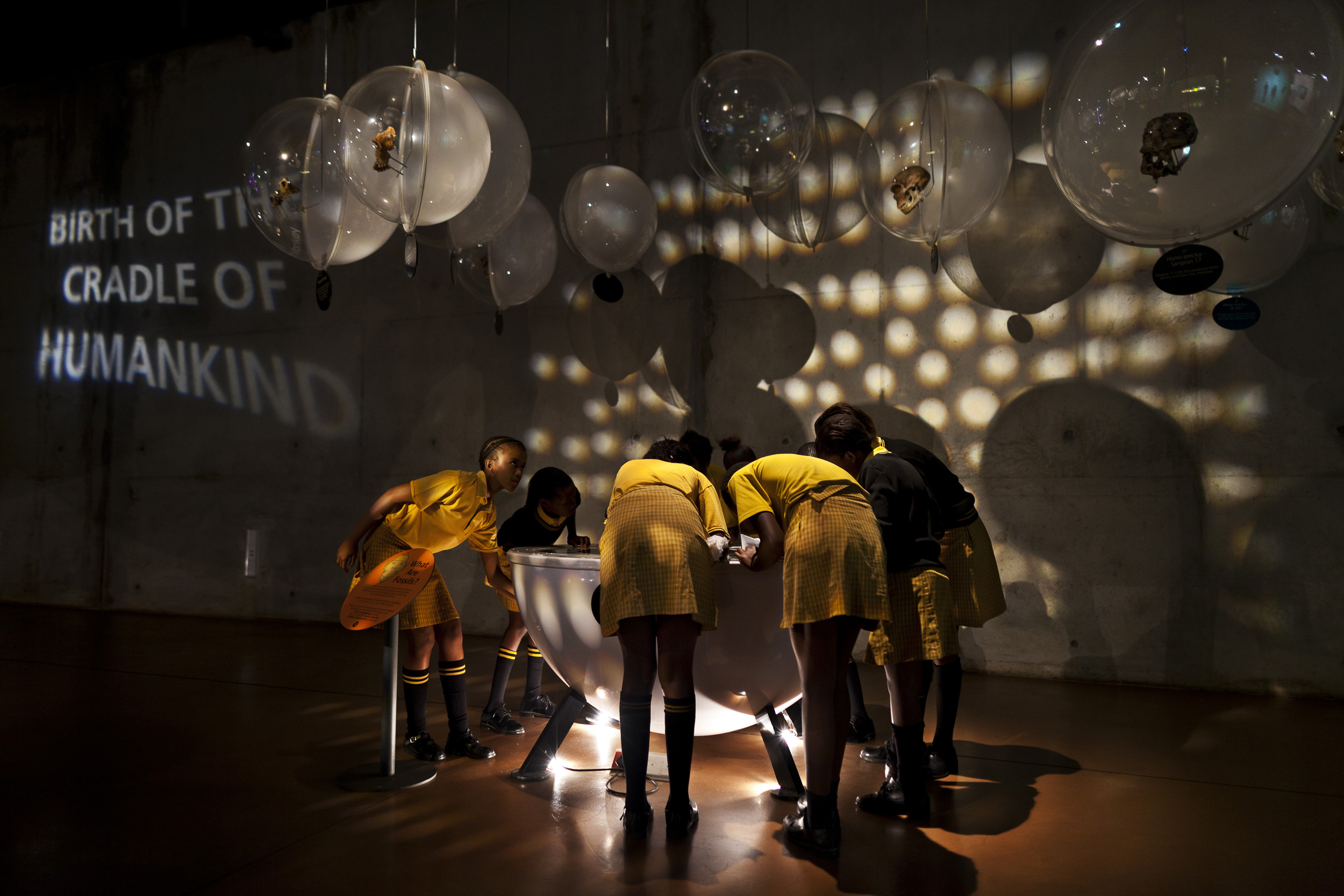
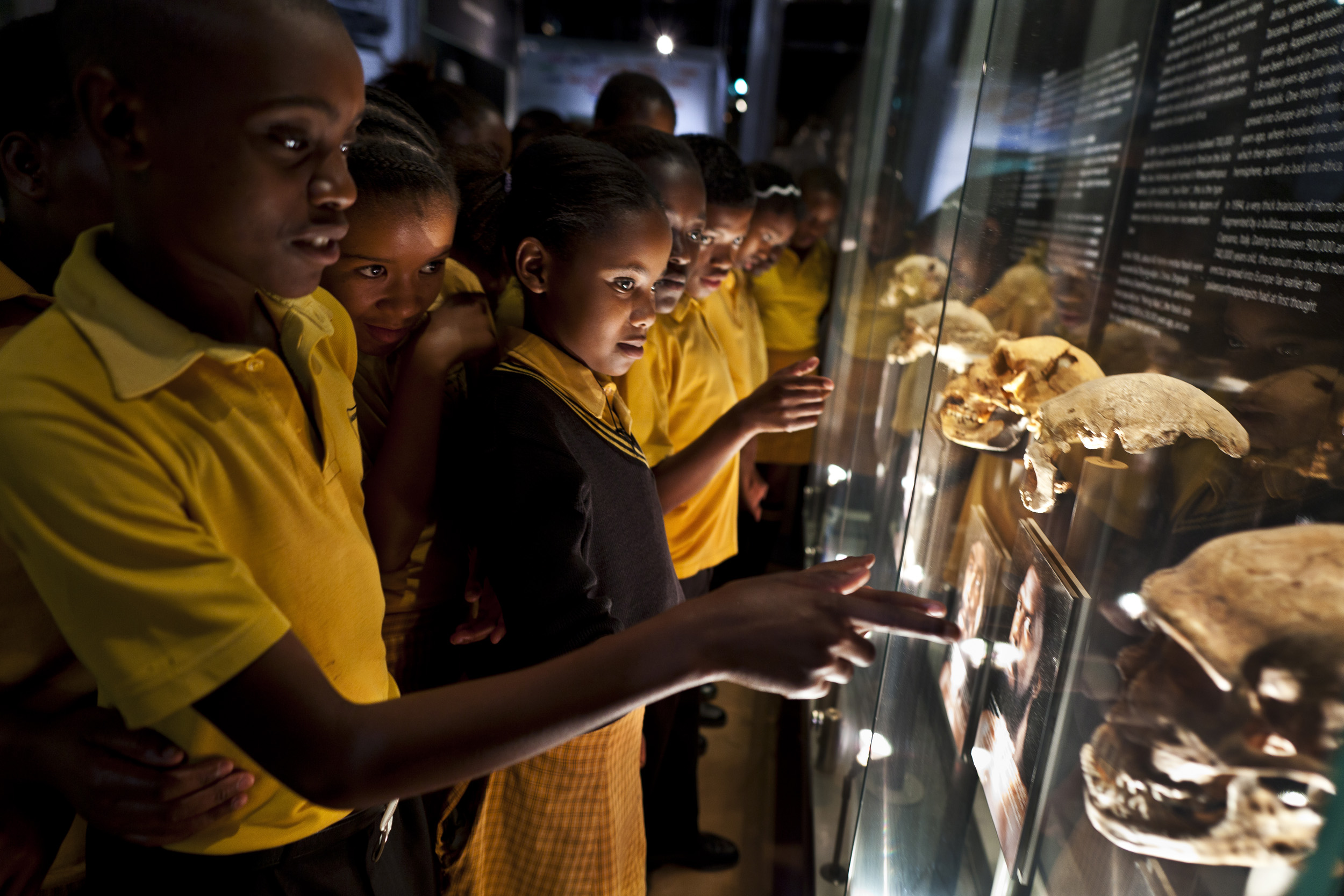
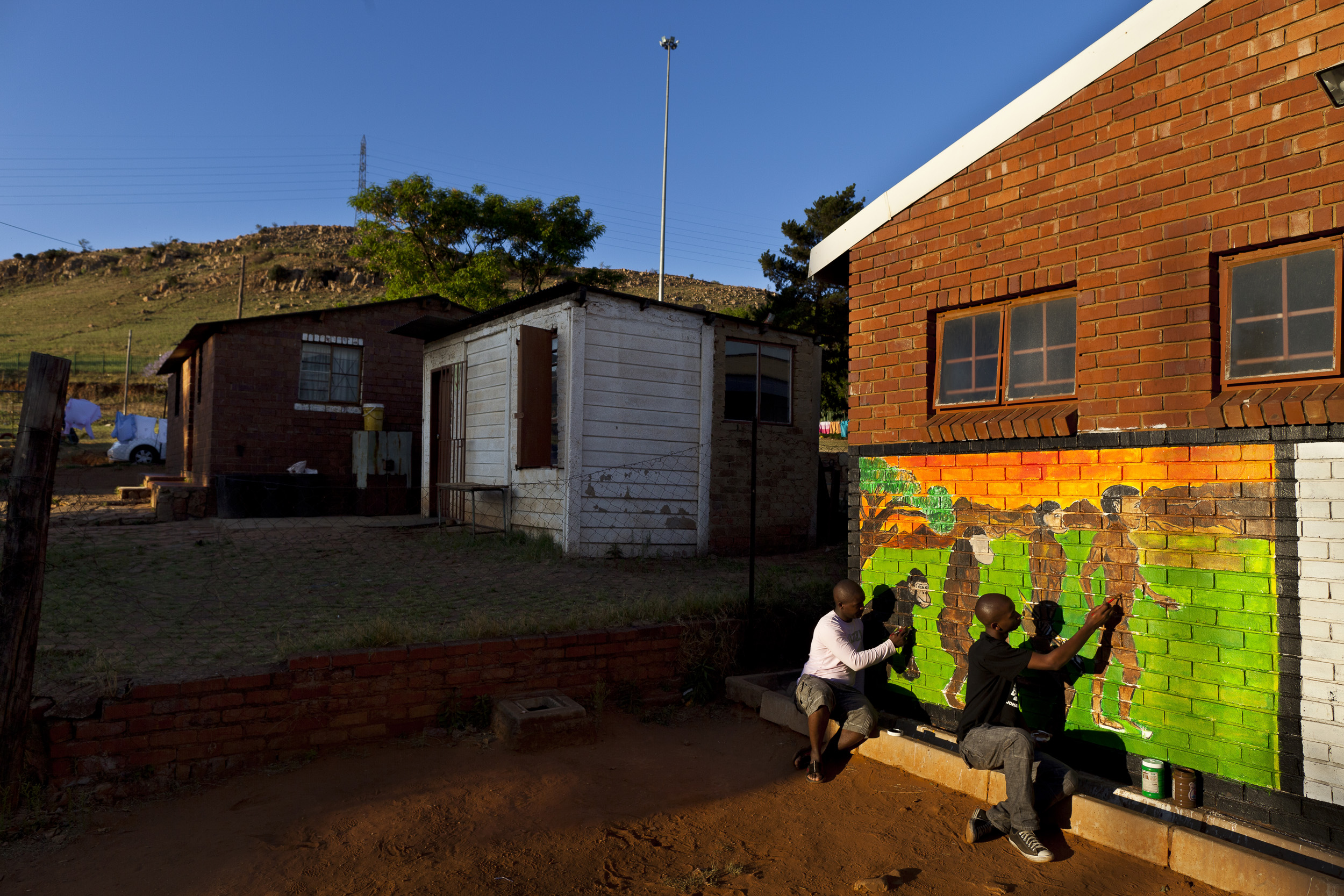
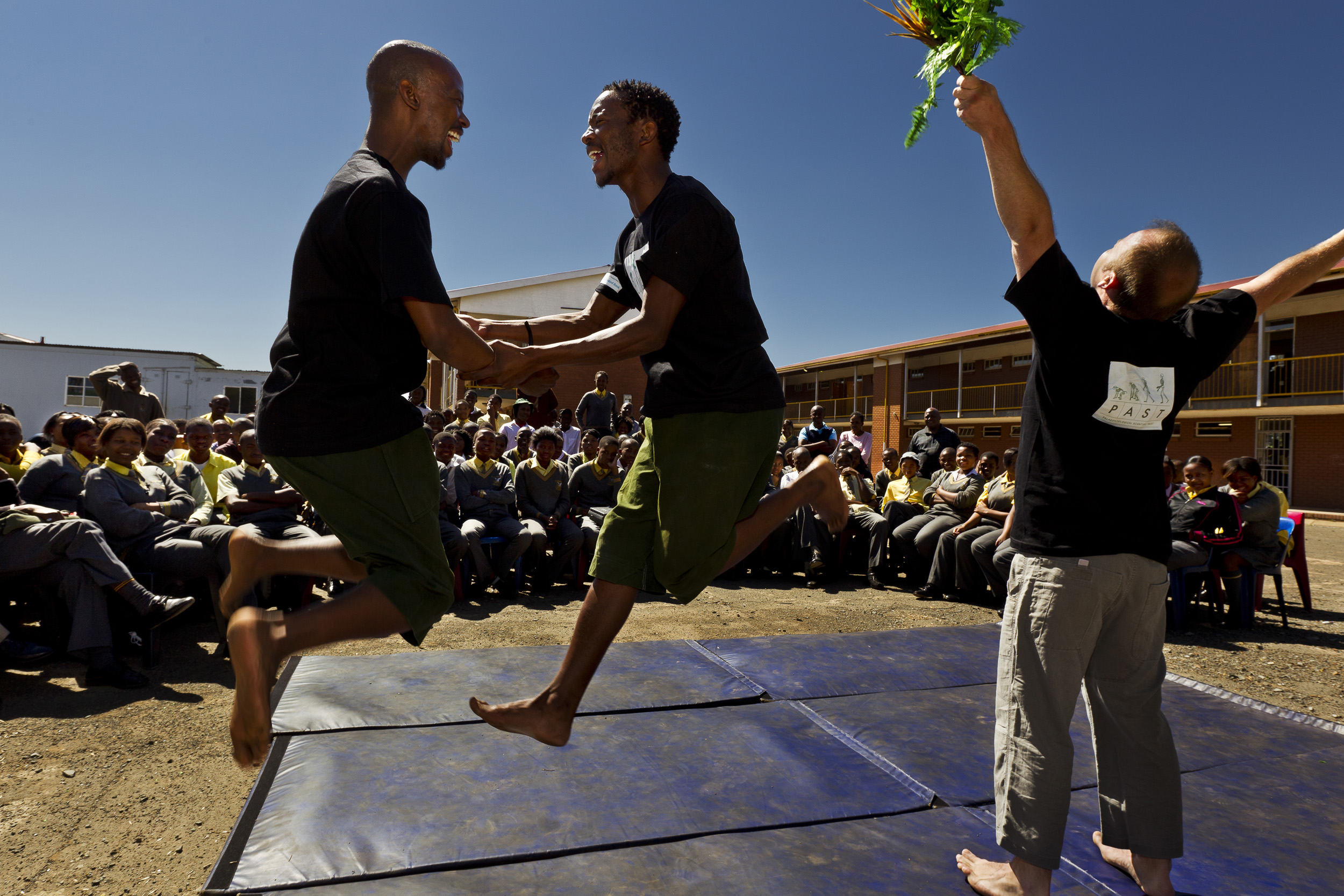
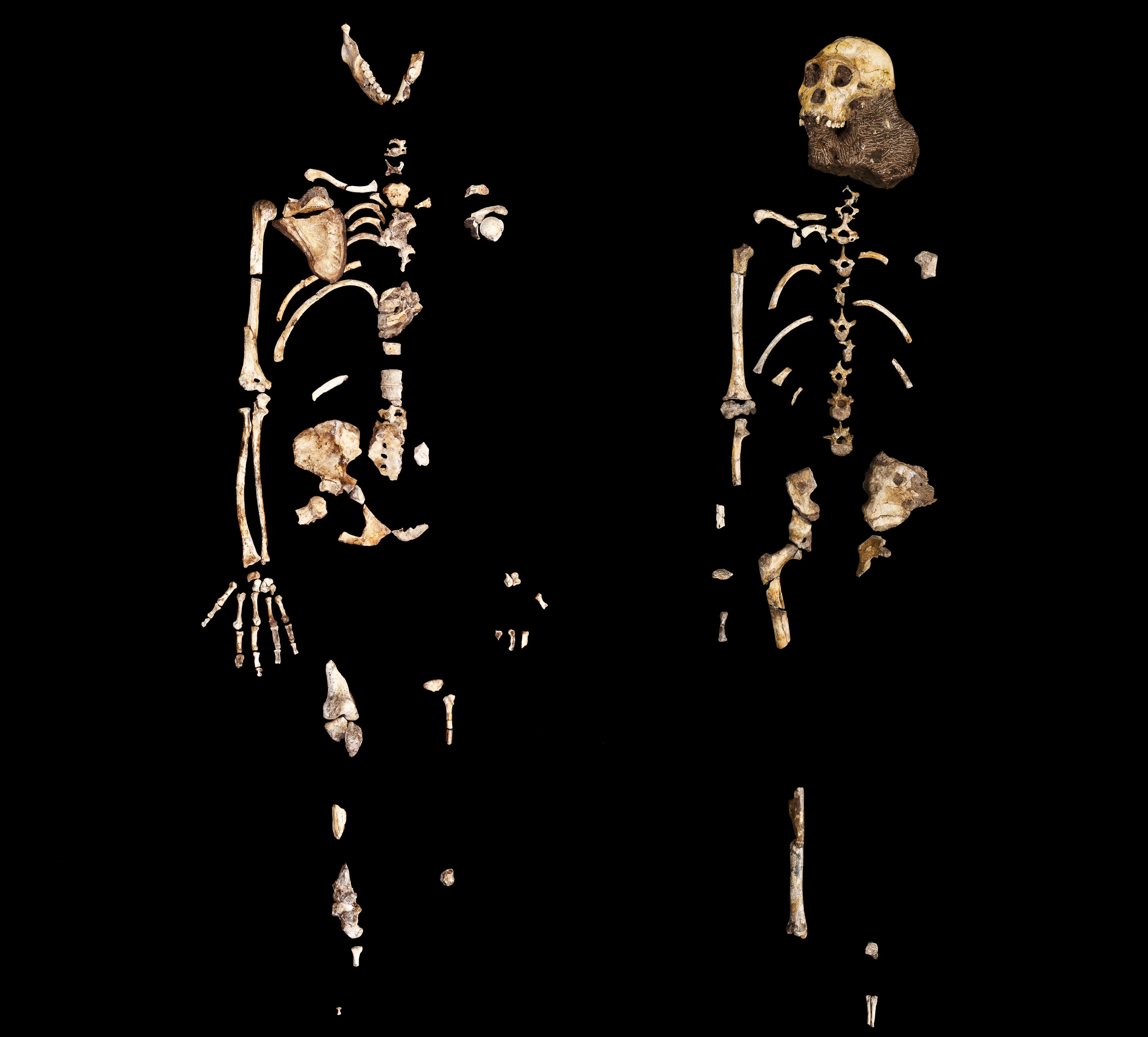
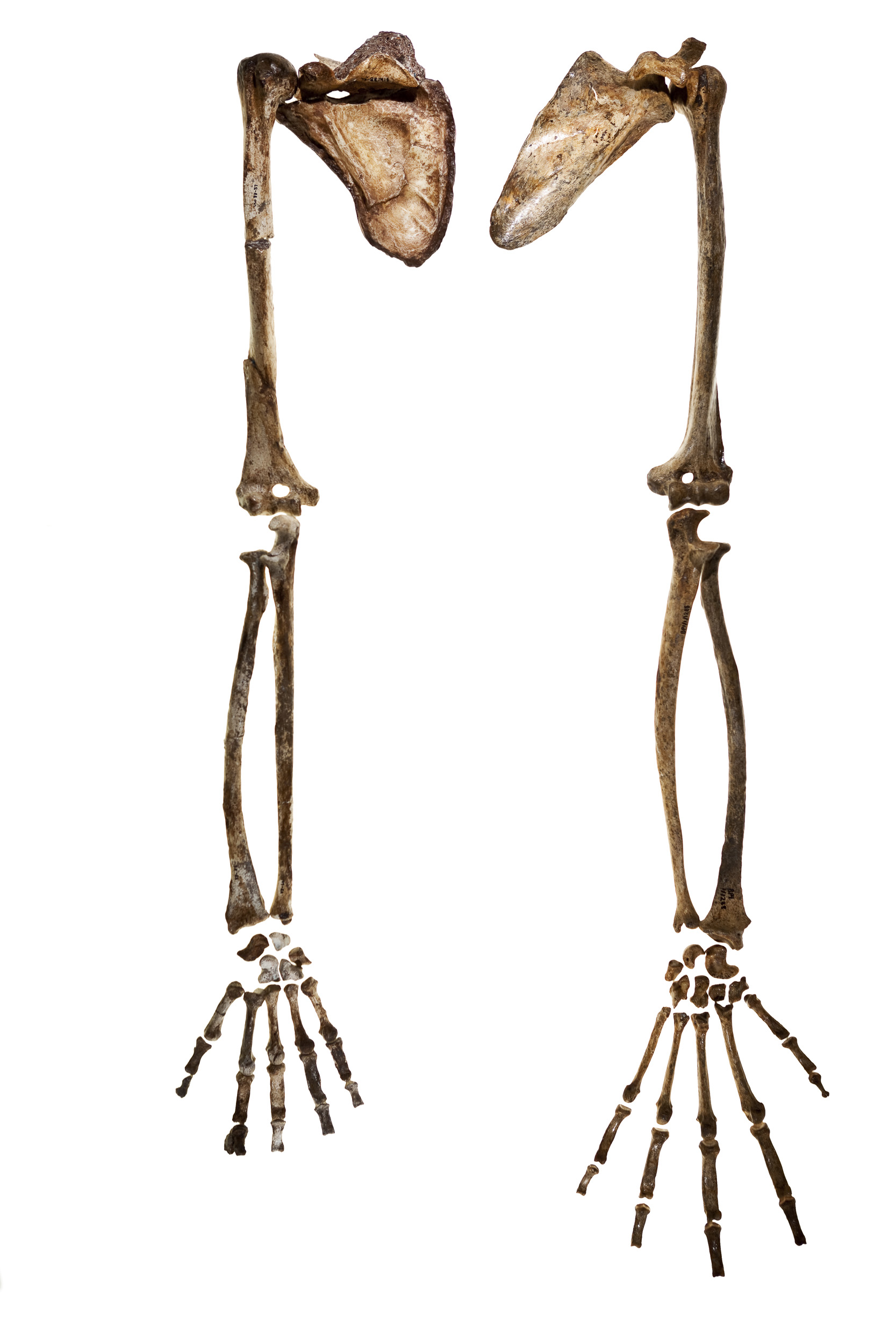
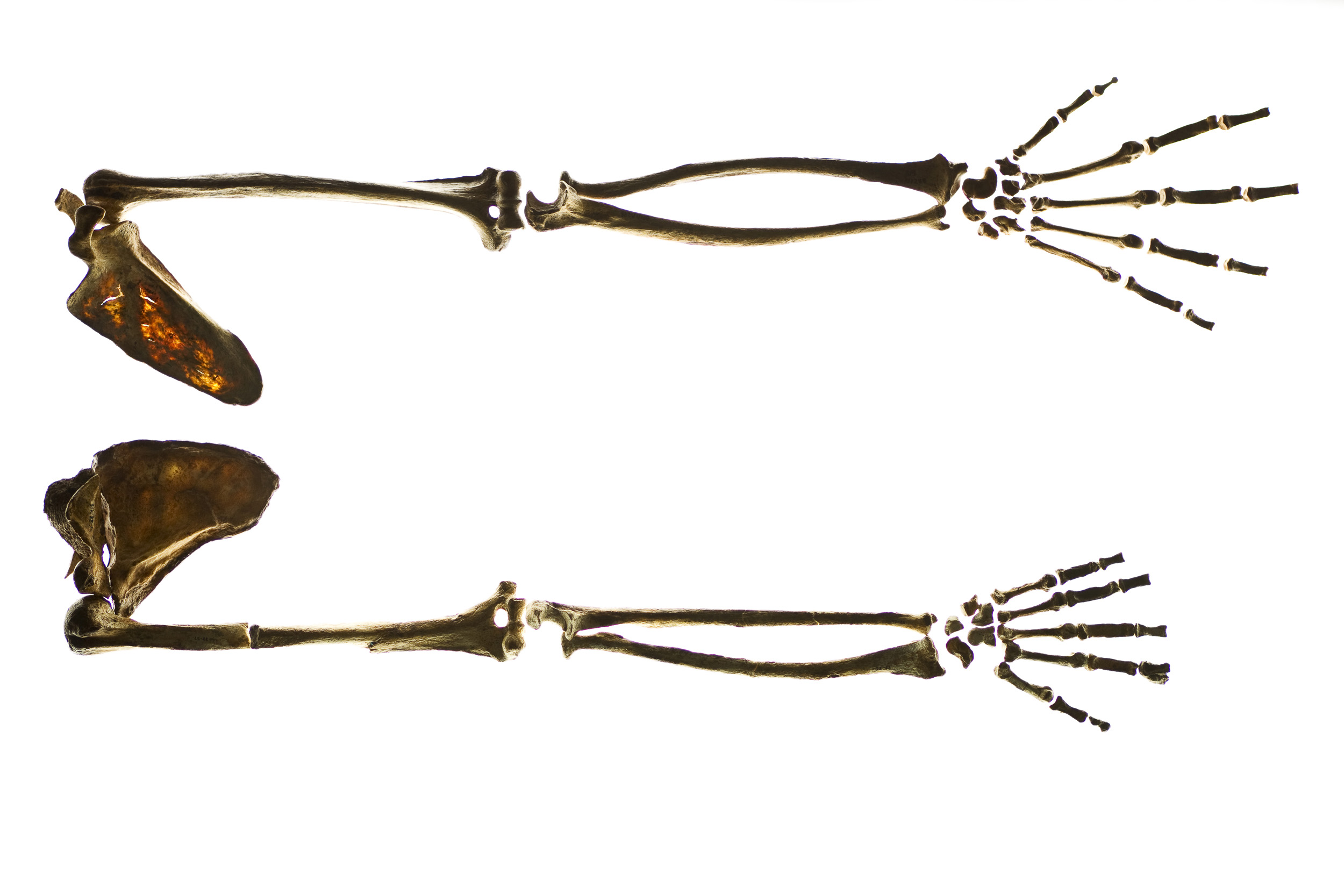
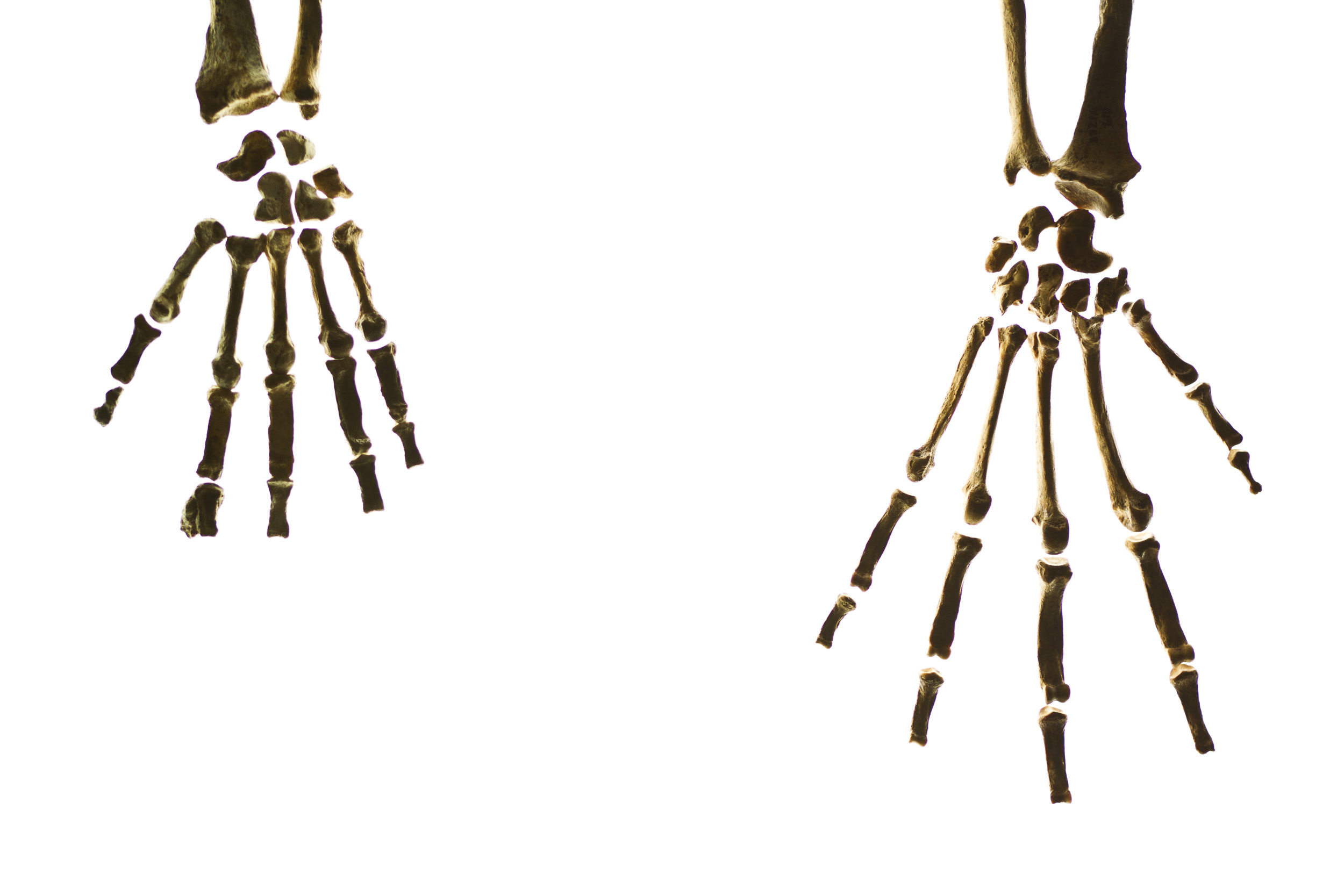
THE CRADLE OF HUMANKIND, GAUTENG, SOUTH AFRICA, OCTOBER, 2010: The "elephant chamber" inside Sterkfontein Caves, Gauteng, South Africa, October 11, 2010. In the recent Sediba finds in the Cradle, it is believed that the hominid fossils wee well preserved as the hominds fell into the cave and were trapped out of reach of predators who would have destroyed the bones we see today. Within the caves of the Cradle of Humankind, scientists have discovered many hominid and other animal fossils, dating back more than 4-million years, to the birth of humanity. The most important and most famous of these fossils are “Mrs Ples”, a 2.1-million-year-old Australopithecus skull, and “Little Foot”, an almost complete Australopithecus skeleton that is more than 3-million years old. These fossils, both found in the Sterkfontein Caves in the Cradle of Humankind, as well as the recent Sediba find, tell us much about the precursors of modern humans. (Photo by Brent Stirton/Reportage for National Geographic.)
THE CRADLE OF HUMANKIND, GAUTENG, SOUTH AFRICA, OCTOBER 2010: Sunset over the Cradle of Humankind as seen from the Maropeng visitor's center at the Cradle of Humankind World Heritage Site, Gauteng, South Africa, 8 October 2010. Maropeng means “returning to the place of origin” in Setswana, the main indigenous language in this area of South Africa. This is a center devoted to human origins and the children undertake a journey into the origins of man as they tour the facility. The recent Sediba discovery has re-energised the Paleolithic world in the minds of people in South Africa and there is more interest in early man and the fossil rich Cradle of Humankind than ever before. (Photo by Brent Stirton/Reportage for National Geographic.)
THE CRADLE OF HUMANKIND, GAUTENG, SOUTH AFRICA, OCTOBER 2010: Sunset overlooking trees in the Cradle of Humankind World Heritage Site, Gauteng, South Africa, 10 October 2010. Trees in the Cradle are often an indicator of caves in this area, the trees are often near underground water sources. The recent Sediba discovery at the Malapa site was a result of Lee Berger's use of Google Earth to map tree clusters which indicated caves in the area. The recent Sediba discovery has re-energised the Paleolithic world in the minds of people in South Africa and there is more interest in early man and the fossil rich Cradle of Humankind than ever before. (Photo by Brent Stirton/Reportage for National Geographic.)
CRADLE OF HUMNAKIND, JOHANNESBURG, SOUTH AFRICA, OCTOBER 2010: Professor Lee Berger of Wits University Paleontology Department sits with his son Matthew at the Malapa Fossil site on the Malapa Nature Reserve in the Cradle of Humankind, Johannesburg, South Africa, October 25 2010. Australophithicus Sediba was found at the Malapa site 18 months ago and has gone one to become perhaps the most important early hominid find in history. Matthew Berger is credited with finding the first Homind fossil at the site, a find which led to a major new Hominid genus being discovered. A juvenile male is emerging largely intact as well as an adult female and it appears there are at least 4 other skeletons at the site. This is the largest find of its kind in history and may rewrite the books on how we view early relations to humankind. (Photo by Brent Stirton/National Geographic.)
CRADLE OF HUMNAKIND, JOHANNESBURG, SOUTH AFRICA, OCTOBER 2010: Professor Lee Berger of Wits University Paleontology Department work with his excavations staff at the Malapa Fossil site on the Malapa Nature Reserve in the Cradle of Humankind, Johannesburg, South Africa, October 25 2010. Australophithicus Sediba was found at the Malapa site 18 months ago and has gone one to become perhaps the most important early hominid find in history. A juvenile male is emerging largely intact as well as an adult female and it appears there are at least 4 other skeletons at the site. This is the largest find of its kind in history and may rewrite the books on how we view early relations to humankind. (Photo by Brent Stirton/National Geographic.)
CRADLE OF HUMNAKIND, JOHANNESBURG, SOUTH AFRICA, OCTOBER 2010: Professor Lee Berger of Wits University Paleontology Department work with his excavations staff at the Malapa Fossil site on the Malapa Nature Reserve in the Cradle of Humankind, Johannesburg, South Africa, October 25 2010. Australophithicus Sediba was found at the Malapa site 18 months ago and has gone one to become perhaps the most important early hominid find in history. A juvenile male is emerging largely intact as well as an adult female and it appears there are at least 4 other skeletons at the site. This is the largest find of its kind in history and may rewrite the books on how we view early relations to humankind. (Photo by Brent Stirton/National Geographic.)
CRADLE OF HUMNAKIND, JOHANNESBURG, SOUTH AFRICA, OCTOBER 2010: Professor Lee Berger of Wits University Paleontology Department work with his excavations staff at the Malapa Fossil site on the Malapa Nature Reserve in the Cradle of Humankind, Johannesburg, South Africa, October 25 2010. Australophithicus Sediba was found at the Malapa site 18 months ago and has gone one to become perhaps the most important early hominid find in history. A juvenile male is emerging largely intact as well as an adult female and it appears there are at least 4 other skeletons at the site. This is the largest find of its kind in history and may rewrite the books on how we view early relations to humankind. (Photo by Brent Stirton/National Geographic.)
CRADLE OF HUMNAKIND, JOHANNESBURG, SOUTH AFRICA, NOVEMBER 2010: Professor Lee Berger of Wits University Paleontology Department works with his crew at the Malapa Fossil site on the Malapa Nature Reserve in the Cradle of Humankind, Johannesburg, South Africa, November 4, 2010. Berger used a hydraulic jack to pressure the matrix and extract homind fossil rich blocks from the site. Australophithicus Sediba was found at the Malapa site 18 months ago and has gone one to become perhaps the most important early hominid find in history. A juvenile male is emerging largely intact as well as an adult female and it appears there are at least 4 other skeletons at the site. This is the largest find of its kind in history and may rewrite the books on how we view early relations to humankind. (Photo by Brent Stirton/National Geographic.)
CRADLE OF HUMNAKIND, JOHANNESBURG, SOUTH AFRICA, NOVEMBER 2010: Professor Lee Berger of Wits University Paleontology Department works with his crew at the Malapa Fossil site on the Malapa Nature Reserve in the Cradle of Humankind, Johannesburg, South Africa, November 4, 2010. Berger used a hydraulic jack to pressure the matrix and extract homind fossil rich blocks from the site. Australophithicus Sediba was found at the Malapa site 18 months ago and has gone one to become perhaps the most important early hominid find in history. A juvenile male is emerging largely intact as well as an adult female and it appears there are at least 4 other skeletons at the site. This is the largest find of its kind in history and may rewrite the books on how we view early relations to humankind. (Photo by Brent Stirton/National Geographic.)
CRADLE OF HUMNAKIND, JOHANNESBURG, SOUTH AFRICA, OCTOBER 2010: Professor Lee Berger of Wits University Paleontology Department work with his excavations staff at the Malapa Fossil site on the Malapa Nature Reserve in the Cradle of Humankind, Johannesburg, South Africa, October 25 2010. Australophithicus Sediba was found at the Malapa site 18 months ago and has gone one to become perhaps the most important early hominid find in history. A juvenile male is emerging largely intact as well as an adult female and it appears there are at least 4 other skeletons at the site. This is the largest find of its kind in history and may rewrite the books on how we view early relations to humankind. (Photo by Brent Stirton/National Geographic.)
CRADLE OF HUMNAKIND, JOHANNESBURG, SOUTH AFRICA, OCTOBER 2010: Professor Lee Berger of Wits University Paleontology Department work with his excavations staff at the Malapa Fossil site on the Malapa Nature Reserve in the Cradle of Humankind, Johannesburg, South Africa, October 25 2010. Australophithicus Sediba was found at the Malapa site 18 months ago and has gone one to become perhaps the most important early hominid find in history. A juvenile male is emerging largely intact as well as an adult female and it appears there are at least 4 other skeletons at the site. This is the largest find of its kind in history and may rewrite the books on how we view early relations to humankind. (Photo by Brent Stirton/National Geographic.)
CRADLE OF HUMNAKIND, JOHANNESBURG, SOUTH AFRICA, OCTOBER 2010: Professor Lee Berger of Wits University Paleontology Department work with his excavations staff at the Malapa Fossil site on the Malapa Nature Reserve in the Cradle of Humankind, Johannesburg, South Africa, October 25 2010. Australophithicus Sediba was found at the Malapa site 18 months ago and has gone one to become perhaps the most important early hominid find in history. A juvenile male is emerging largely intact as well as an adult female and it appears there are at least 4 other skeletons at the site. This is the largest find of its kind in history and may rewrite the books on how we view early relations to humankind. (Photo by Brent Stirton/National Geographic.)
CRADLE OF HUMNAKIND, JOHANNESBURG, SOUTH AFRICA, OCTOBER 2010: Professor Lee Berger of Wits University Paleontology Department work with his excavations staff at the Malapa Fossil site on the Malapa Nature Reserve in the Cradle of Humankind, Johannesburg, South Africa, October 25 2010. Australophithicus Sediba was found at the Malapa site 18 months ago and has gone one to become perhaps the most important early hominid find in history. A juvenile male is emerging largely intact as well as an adult female and it appears there are at least 4 other skeletons at the site. This is the largest find of its kind in history and may rewrite the books on how we view early relations to humankind. (Photo by Brent Stirton/National Geographic.)
JOHANNESBURG, SOUTH AFRICA, OCTOBER 2010: Excavators from the Sediba hominid project at Wits University go through rock matrix extracted from a fossil site looking for evidence of hominid remains, Johannesburg, South Africa, 4 October, 2010. The Sediba fossil find represents a new Hominid genus, something not seen before. The find at Malapa in the Cradle of Humankind area of South Africa are unprecented in their scale. There are so far an adult female and juvenile male who are almost intact as well as evidence of at least 4 other skeletons. There has never been a find of similar scale in the homind section of the Paleotological world. Over 76 scientists around the world are currently working together on this project. (Photo by Brent Stirton/Reportage for National Geographic.)
JOHANNESBURG, SOUTH AFRICA, OCTOBER 2010: Excavators from the Sediba hominid project at Wits University go through rock matrix extracted from a fossil site looking for evidence of hominid remains, Johannesburg, South Africa, 4 October, 2010. The Sediba fossil find represents a new Hominid genus, something not seen before. The find at Malapa in the Cradle of Humankind area of South Africa are unprecented in their scale. There are so far an adult female and juvenile male who are almost intact as well as evidence of at least 4 other skeletons. There has never been a find of similar scale in the homind section of the Paleotological world. Over 76 scientists around the world are currently working together on this project. (Photo by Brent Stirton/Reportage for National Geographic.)
JOHANNESBURG, SOUTH AFRICA, OCTOBER 2010: Excavators from the Sediba hominid project at Wits University go through rock matrix extracted from a fossil site looking for evidence of hominid remains, Johannesburg, South Africa, 4 October, 2010. The Sediba fossil find represents a new Hominid genus, something not seen before. The find at Malapa in the Cradle of Humankind area of South Africa are unprecented in their scale. There are so far an adult female and juvenile male who are almost intact as well as evidence of at least 4 other skeletons. There has never been a find of similar scale in the homind section of the Paleotological world. Over 76 scientists around the world are currently working together on this project. (Photo by Brent Stirton/Reportage for National Geographic.)
JOHANNESBURG, SOUTH AFRICA, OCTOBER 2010: Preperation Lab Technicans at Wits University Paleo Sciences department extract new hominid fossil finds from rock matrix found at the Malapa hominid project side, Johannesburg, South Africa, 6 October, 2010. These finds are precisely copied in resin and the copies are then utilised across the world by scientists working on the project as well as educators across the paleolithic spectrum. The Sediba fossil find represents a new Hominid genus, something not seen before. The find at Malapa in the Cradle of Humankind area of South Africa are unprecented in their scale. There are so far an adult female and juvenile male who are almost intact as well as evidence of at least 4 other skeletons. There has never been a find of similar scale in the homind section of the Paleotological world. Over 76 scientists around the world are currently working together on this project. (Photo by Brent Stirton/Reportage for National Geographic.)
JOHANNESBURG, SOUTH AFRICA, OCTOBER 2010: Preperation Lab Technican Celeste Yates of Wits University Paleo Sciences department extracts 4 adult articulated verterbrae from rock matrix found at the Malapa hominid site, Johannesburg, South Africa, 17 October, 2010. These unique finds are then precisely copied in resin and the copies utilised across the world by participating scientists working on the project across the paleolithic spectrum. The Sediba fossil find represents a possible new Hominid genus, something not seen before. The finds at Malapa in the Cradle of Humankind area of South Africa are unprecented in their scale. There are so far an adult female and juvenile male who are almost intact as well as evidence of at least 4 other skeletons. There has never been a find of similar scale in the homind section of the Paleotological world. Over 76 scientists around the world are currently working together on this project. (Photo by Brent Stirton/Reportage for National Geographic.)
JOHANNESBURG, SOUTH AFRICA, OCTOBER 2010: Kristian Carlson, a scientist from the Institute for Human Evolution at Wits University works on CT scans of hominid fossils at Wits University Paleolithic department, Johannesburg, South Africa, 7 October, 2010. Carlson specialises in digital reconstruction that better explains fossil morphology and behavior interpretation. These scans have allowed for detailed computer reconstruction and subsequent resion recreations of how these Hominids once functioned and looked. (Photo by Brent Stirton/Reportage for National Geographic.)
JOHANNESBURG, SOUTH AFRICA, OCTOBER 2010: Kristian Carlson and Aurore Val, scientists from the Institute for Human evolution at Wits University, checks CT scans of hominid fossils at Wits Paleolithic department, Johannesburg, South Africa, 7 October, 2010. Carlson specialises in digital reconstruction that better explains fossil morphology and behavior interpretation. These scans have allowed for detailed computer reconstruction and subsequent resion recreations of how these Hominids once functioned and looked. (Photo by Brent Stirton/Reportage for National Geographic.)
JOHANNESBURG, SOUTH AFRICA, OCTOBER 2010: Casting Lab Technicans at Wits University Paleo Sciences department work on the Sediba hominid project making precise resin copies of fossil finds, Johannesburg, South Africa, 5 October, 2010. These copies are then utilised across the world by scientists working on the project as well as educators across the paleolithic spectrum. The Sediba fossil find represents a new Hominid genus, something not seen before. The find at Malapa in the Cradle of Humankind area of South Africa are unprecented in their scale. There are so far an adult female and juvenile male who are almost intact as well as evidence of at least 4 other skeletons. There has never been a find of similar scale in the homind section of the Paleotological world. Over 76 scientists around the world are currently working together on this project. (Photo by Brent Stirton/Reportage for National Geographic.)
JOHANNESBURG, SOUTH AFRICA, OCTOBER 2010: Casting Lab Technicans at Wits University Paleo Sciences department work on the Sediba hominid project making precise resin copies of fossil finds, Johannesburg, South Africa, 5 October, 2010. These copies are then utilised across the world by scientists working on the project as well as educators across the paleolithic spectrum. The Sediba fossil find represents a new Hominid genus, something not seen before. The find at Malapa in the Cradle of Humankind area of South Africa are unprecented in their scale. There are so far an adult female and juvenile male who are almost intact as well as evidence of at least 4 other skeletons. There has never been a find of similar scale in the homind section of the Paleotological world. Over 76 scientists around the world are currently working together on this project. (Photo by Brent Stirton/Reportage for National Geographic.)
JOHANNESBURG, SOUTH AFRICA, OCTOBER 2010: Casting Lab Technicans at Wits University Paleo Sciences department work on the Sediba hominid project making precise resin copies of fossil finds, Johannesburg, South Africa, 5 October, 2010. These copies are then utilised across the world by scientists working on the project as well as educators across the paleolithic spectrum. The Sediba fossil find represents a new Hominid genus, something not seen before. The find at Malapa in the Cradle of Humankind area of South Africa are unprecented in their scale. There are so far an adult female and juvenile male who are almost intact as well as evidence of at least 4 other skeletons. There has never been a find of similar scale in the homind section of the Paleotological world. Over 76 scientists around the world are currently working together on this project. (Photo by Brent Stirton/Reportage for National Geographic.)
JOHANNESBURG, SOUTH AFRICA, OCTOBER 2010: Professor Lee Berger teaches an early man fossil class to students inside the fossil vault at the Wits University Medical department, Johannesburg, South Africa, 12 October, 2010. Professor Berger has been responsible for a number of important Hominid fossil discoveries, the most recent of which is the Sediba fossil, this find represents a new Hominid genus, something not seen before in the evolution of early man. These fossil finds at Malapa in the Cradle of Humankind area of South Africa are unprecented in their completeness and sheer number. There are so far an adult female and juvenile male who are almost intact as well as evidence of at least 4 other skeletons. There has never been a find of similar scale in the homind section of the Paleotological world. Over 76 scientists around the world are currently working together on this project. (Photo by Brent Stirton/Reportage for National Geographic.)
THE CRADLE OF HUMANKIND, GAUTENG, SOUTH AFRICA, OCTOBER 2010: Schoolchildren from the Marapo A-Thutlwa Primary school visit Maropeng visitor's center at the Cradle of Humankind World Heritage Site, Gauteng, South Africa, 8 October 2010. Maropeng means “returning to the place of origin” in Setswana, the main indigenous language in this area of South Africa. This is a center devoted to human origins and the children undertake a journey into the origins of man as they tour the facility. The recent Sediba discovery has re-energised the Paleolithic world in the minds of people in South Africa and there is more interest in early man and the fossil rick Cradle of Humankind than ever before. (Photo by Brent Stirton/Reportage for National Geographic.)
THE CRADLE OF HUMANKIND, GAUTENG, SOUTH AFRICA, OCTOBER 2010: Schoolchildren from the Marapo A-Thutlwa Primary school visit Maropeng visitor's center at the Cradle of Humankind World Heritage Site, Gauteng, South Africa, 8 October 2010. Maropeng means “returning to the place of origin” in Setswana, the main indigenous language in this area of South Africa. This is a center devoted to human origins and the children undertake a journey into the origins of man as they tour the facility. The recent Sediba discovery has re-energised the Paleolithic world in the minds of people in South Africa and there is more interest in early man and the fossil rick Cradle of Humankind than ever before. (Photo by Brent Stirton/Reportage for National Geographic.)
MAMELODI, PRETORIA, SOUTH AFRICA, OCTOBER 2010: Artists Mabote Boy Louw, 22, and Given Fortune Bongani Nkosi, 22, work on a mural of the evolution of man at a school in Mamelodi township, Pretoria, South Africa, 16 October 2010. Nkosi and Louw spend their working week creating casts of the Malapa fossils at Wits Paleo Center, working with others to create accurate replicas of the Hominid fossils for distribution to the scientists working on this project around the world. Nkosi and Louw were selected for this job after they won a competition for artists run by the American Embassy in Johannesburg. Both men are interested in spreading knowledge of the Paleo history of South Africa amongst the townships of the country and are trying to initiate a mural project based on images of early man. (Photo by Brent Stirton/Reportage for National Geographic.)
JOHANNESBURG, SOUTH AFRICA, OCTOBER 2010. Member's of P.A.S.T's Walking Tall Educational Theatre Project perform an educational theater piece on the evolution of man in Khatlahong Township, Johannesburg, South Africa, 15 October, 2010. P.A.S.T is an organisation which specialises in a number of public awareness, education and research projects concerned with the Paleo sciences. They act as a facilitator creating links between government, business, scientists and the public. The Walking Tall project consists of three actors who perform a 45 minute long theatre piece for schoolchildren at schools across the country. It is a very entertaining and amusing skit on evolution and provides an educational platform which is in high demand. After the piece the kids have the opportunity to answer questions of a Paleo nature which the perfomers and a accompanying expert will answer. (Photo by Brent Stirton/Reportage for National Geographic.)
JOHANNESBURG, SOUTH AFRICA, OCTOBER 2010: The skeleton of adult female Mh2 Australopithicus sediba from the Malapa Hominid find as seen at Wits University Paleo Sciences department, Johannesburg, South Africa, 26 October, 2010. This is the most complete Hominid skeleton ever found. These finds are precisely copied in resin and the copies are then utilised across the world by scientists working on the project as well as educators across the paleolithic spectrum. The Sediba fossil find represents a new Hominid genus, something not seen before. The find at Malapa in the Cradle of Humankind area of South Africa are unprecented in their scale. There are so far an adult female, MH2 and a juvenile male, MH1, who are almost intact as well as evidence of at least 4 other skeletons. There has never been a find of similar scale in the homind section of the Paleological world. Over 76 scientists around the world are currently working together on this project. (Photo by Brent Stirton/Reportage for National Geographic.)
JOHANNESBURG, SOUTH AFRICA, OCTOBER 2010: The scapula, arm and hand of adult female Mh2 Australopithicus sediba from the Malapa Hominid find lying next to the scapula, arm and hand of a Bonobo Chimpanzee, as seen at Wits University Paleo Sciences department, Johannesburg, South Africa, 05 November, 2010. This is the most complete Hominid skeleton ever found. These finds are precisely copied in resin and the copies are then utilised across the world by scientists working on the project as well as educators across the paleolithic spectrum. The Sediba fossil find represents a new Hominid genus, something not seen before. The find at Malapa in the Cradle of Humankind area of South Africa are unprecented in their scale. There are so far an adult female, MH2 and a juvenile male, MH1, who are almost intact as well as evidence of at least 4 other skeletons. There has never been a find of similar scale in the homind section of the Paleological world. Over 76 scientists around the world are currently working together on this project. (Photo by Brent Stirton/Reportage for National Geographic.)
JOHANNESBURG, SOUTH AFRICA, OCTOBER 2010: The scapula, arm and hand of adult female Mh2 Australopithicus sediba from the Malapa Hominid find lying next to the scapula, arm and hand of a Bonobo Chimpanzee, as seen at Wits University Paleo Sciences department, Johannesburg, South Africa, 05 November, 2010. This is the most complete Hominid skeleton ever found. These finds are precisely copied in resin and the copies are then utilised across the world by scientists working on the project as well as educators across the paleolithic spectrum. The Sediba fossil find represents a new Hominid genus, something not seen before. The find at Malapa in the Cradle of Humankind area of South Africa are unprecented in their scale. There are so far an adult female, MH2 and a juvenile male, MH1, who are almost intact as well as evidence of at least 4 other skeletons. There has never been a find of similar scale in the homind section of the Paleological world. Over 76 scientists around the world are currently working together on this project. (Photo by Brent Stirton/Reportage for National Geographic.)
JOHANNESBURG, SOUTH AFRICA, OCTOBER 2010: The scapula, arm and hand of adult female Mh2 Australopithicus sediba from the Malapa Hominid find lying next to the scapula, arm and hand of a Bonobo Chimpanzee, as seen at Wits University Paleo Sciences department, Johannesburg, South Africa, 05 November, 2010. This is the most complete Hominid skeleton ever found. These finds are precisely copied in resin and the copies are then utilised across the world by scientists working on the project as well as educators across the paleolithic spectrum. The Sediba fossil find represents a new Hominid genus, something not seen before. The find at Malapa in the Cradle of Humankind area of South Africa are unprecented in their scale. There are so far an adult female, MH2 and a juvenile male, MH1, who are almost intact as well as evidence of at least 4 other skeletons. There has never been a find of similar scale in the homind section of the Paleological world. Over 76 scientists around the world are currently working together on this project. (Photo by Brent Stirton/Reportage for National Geographic.)
